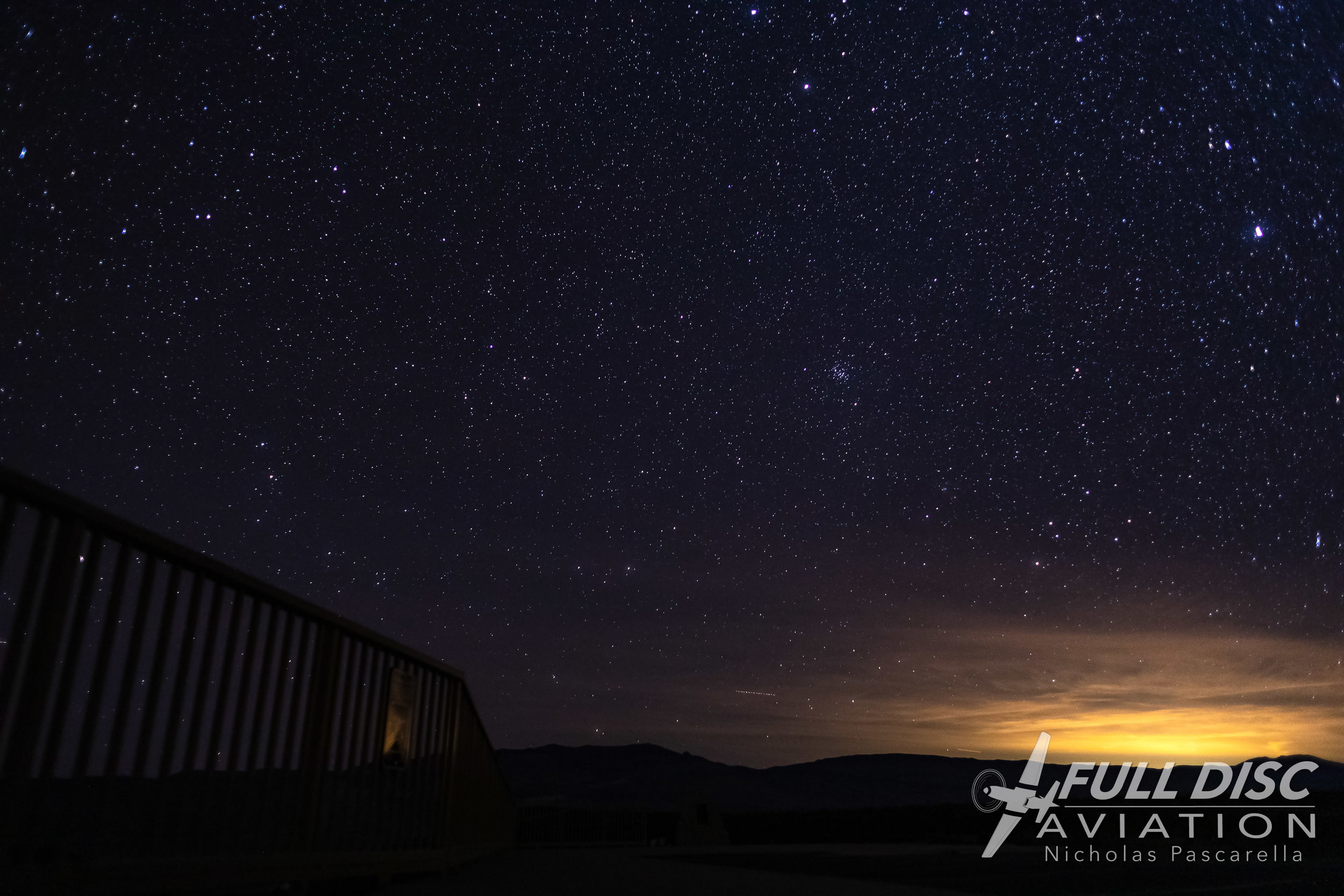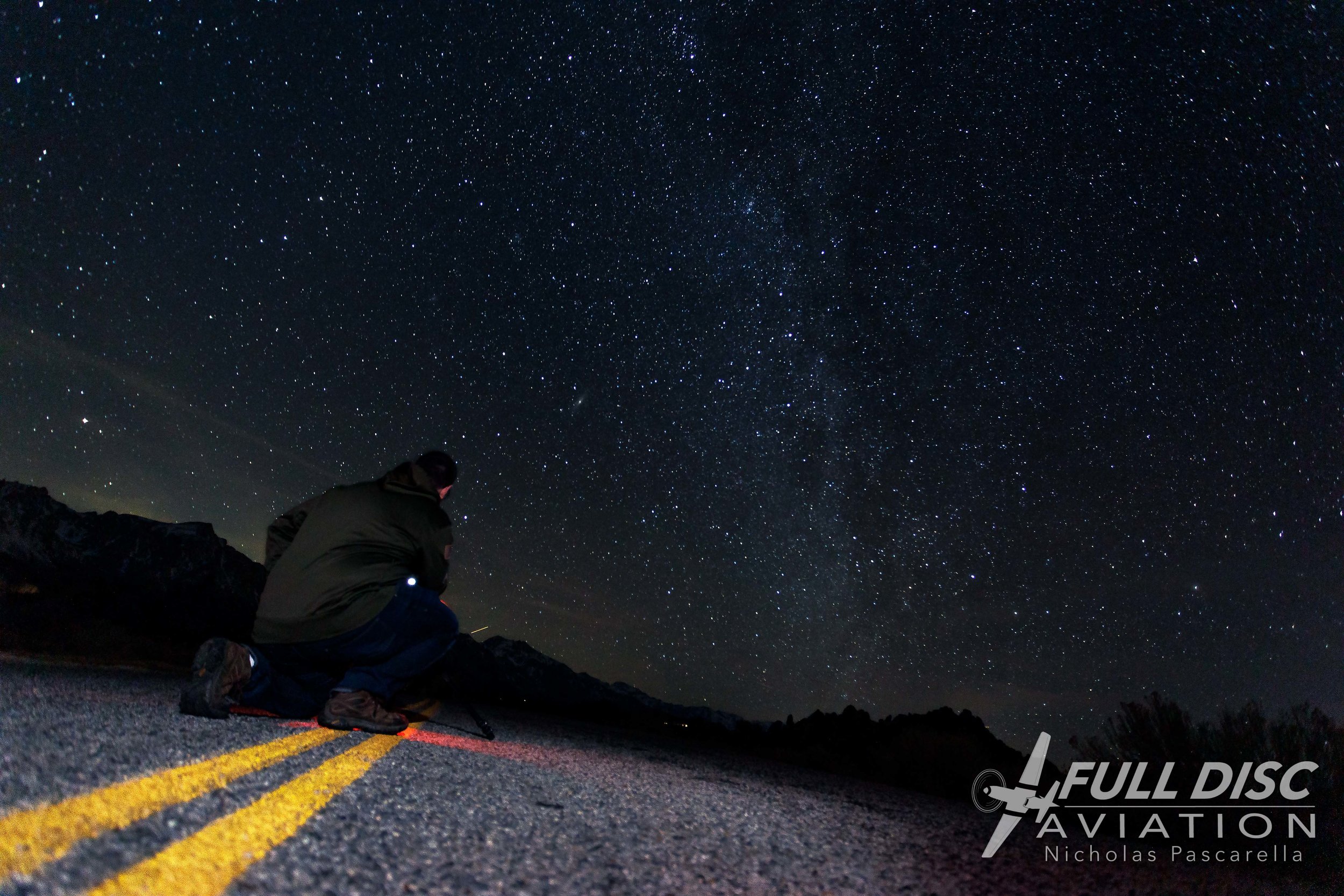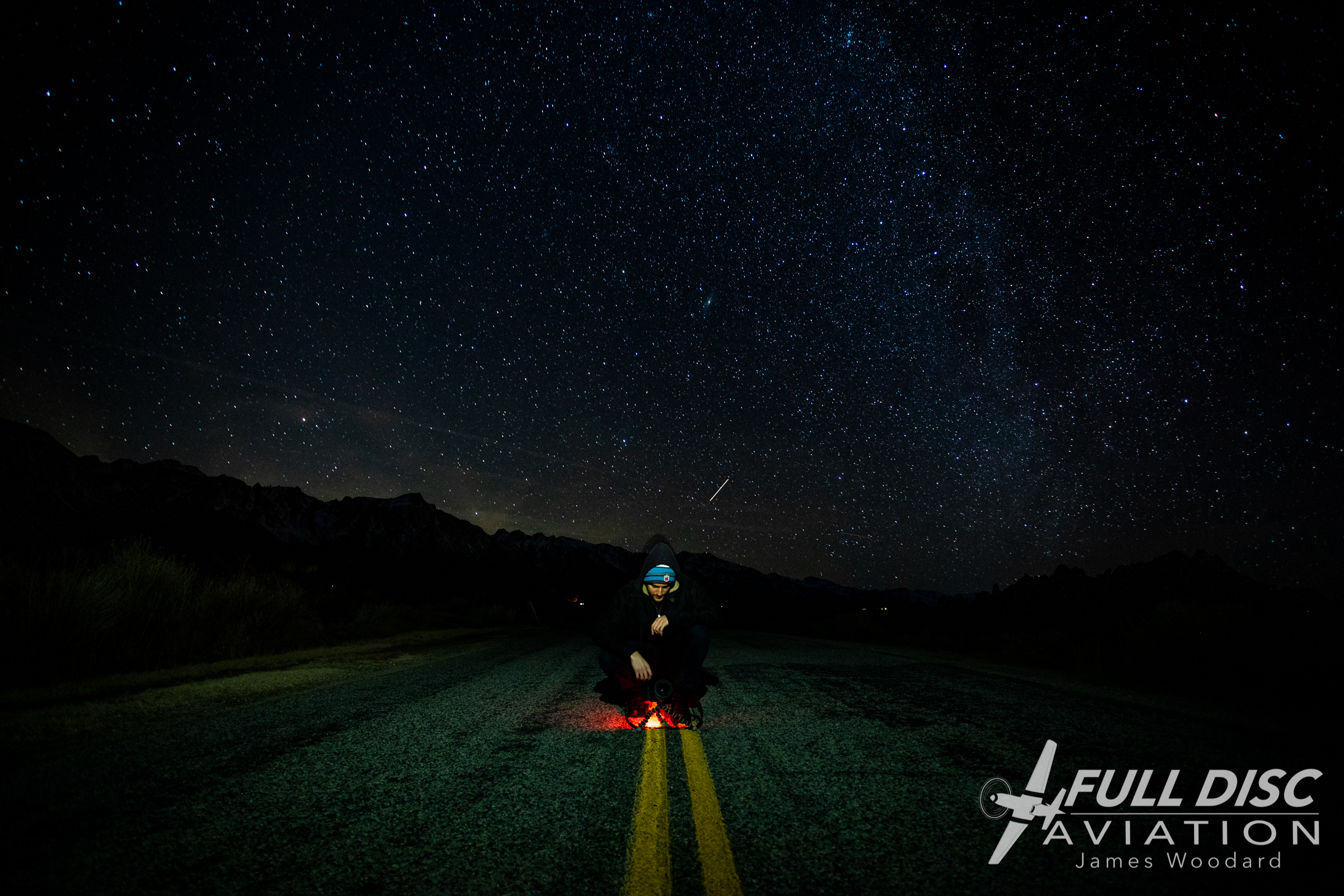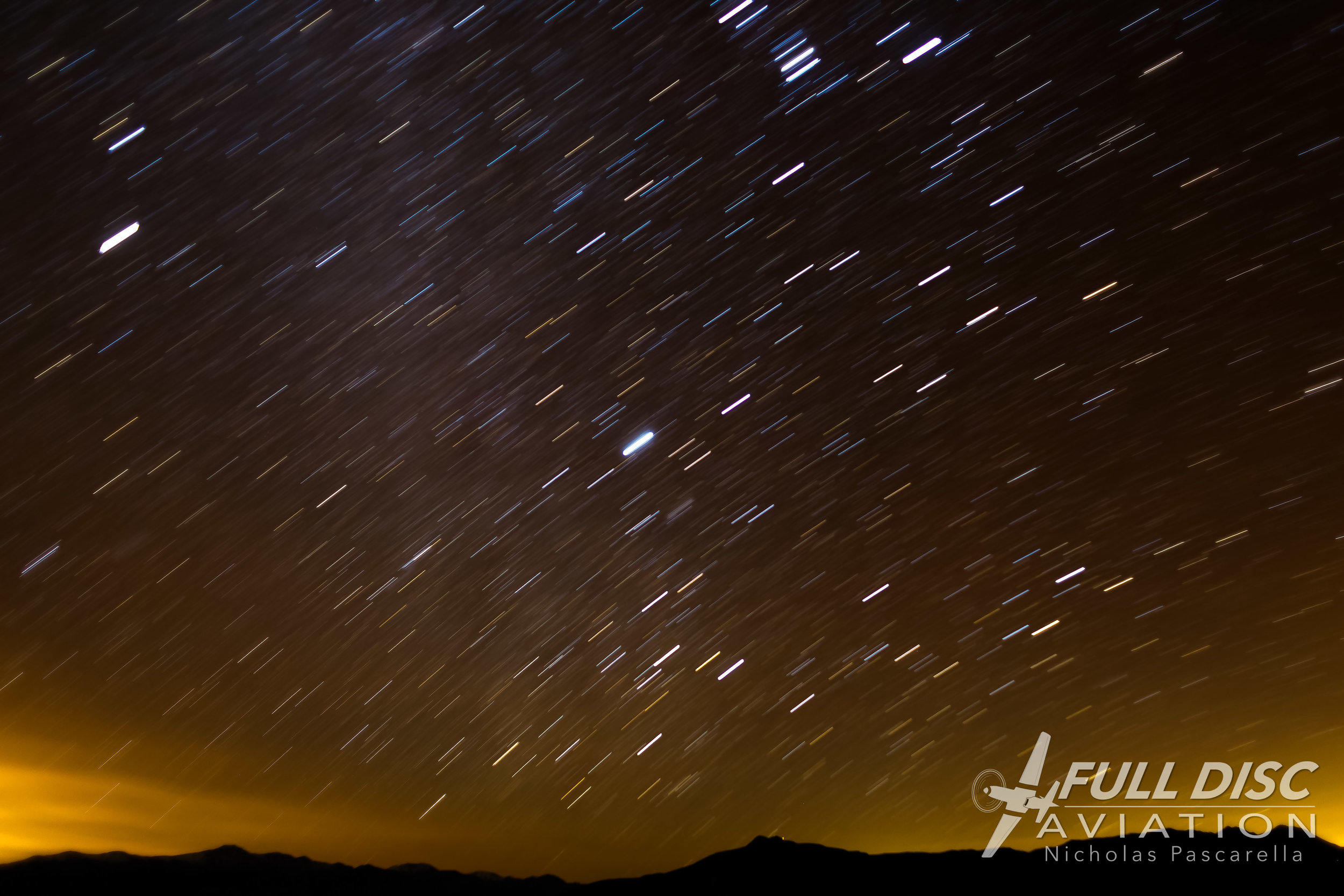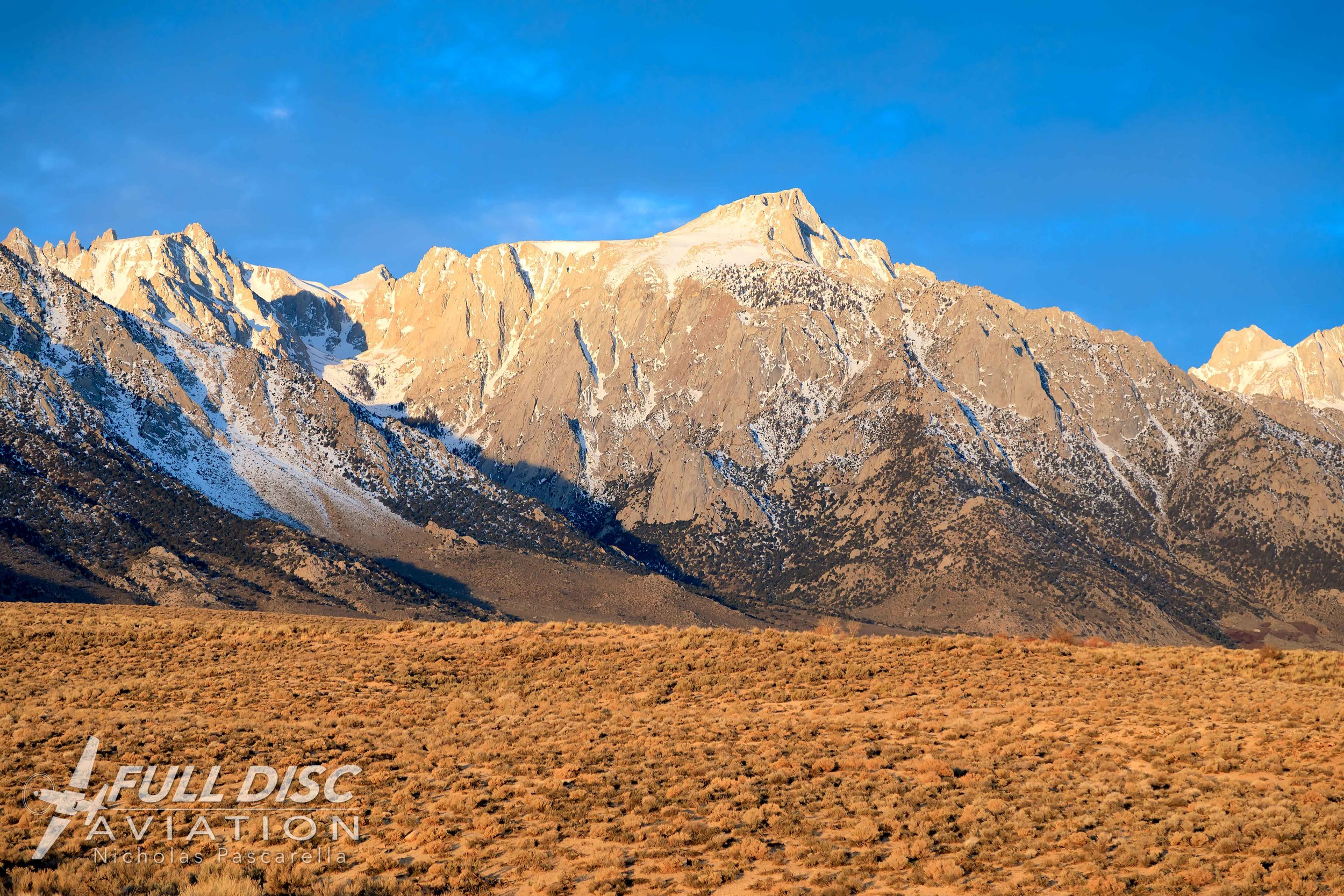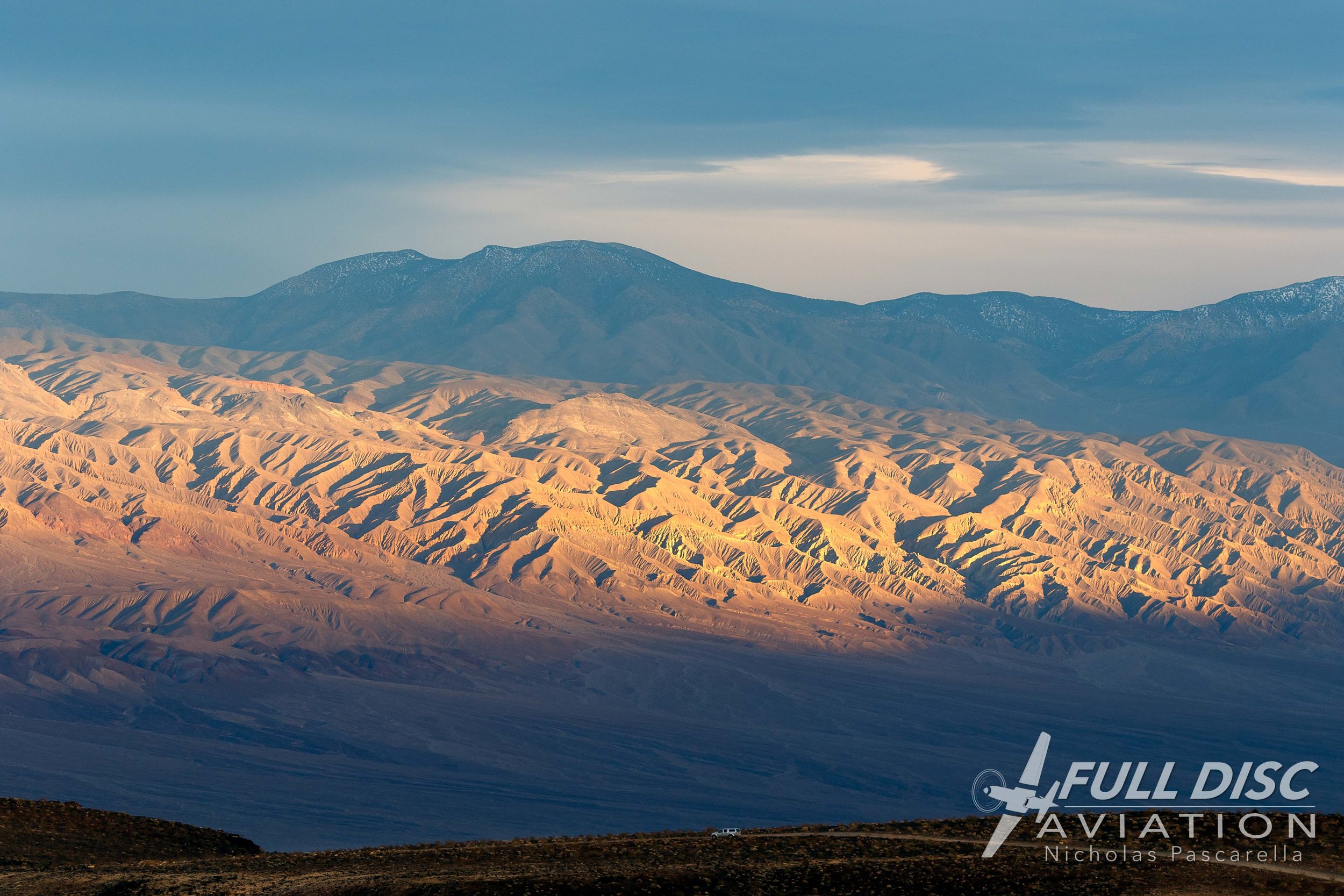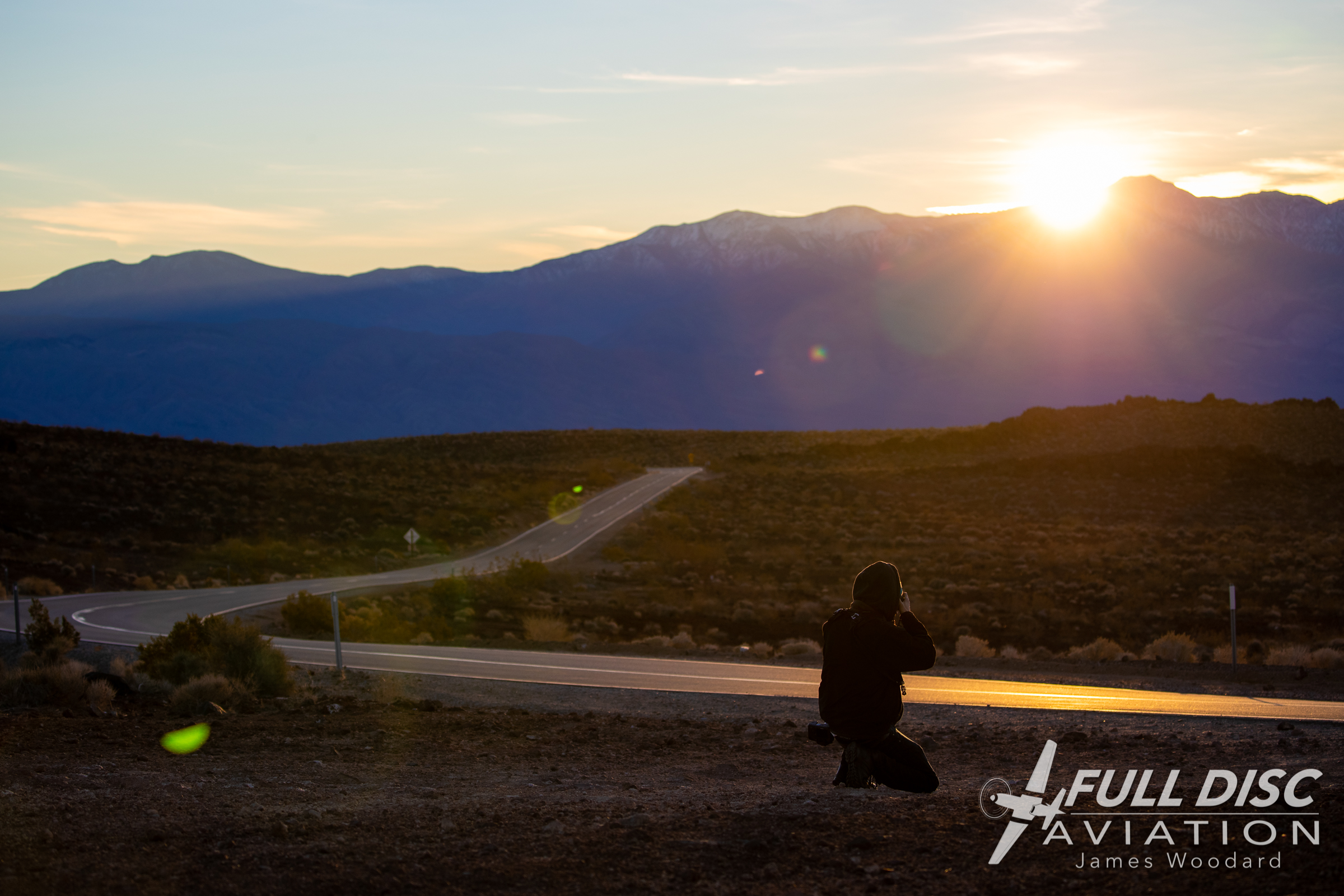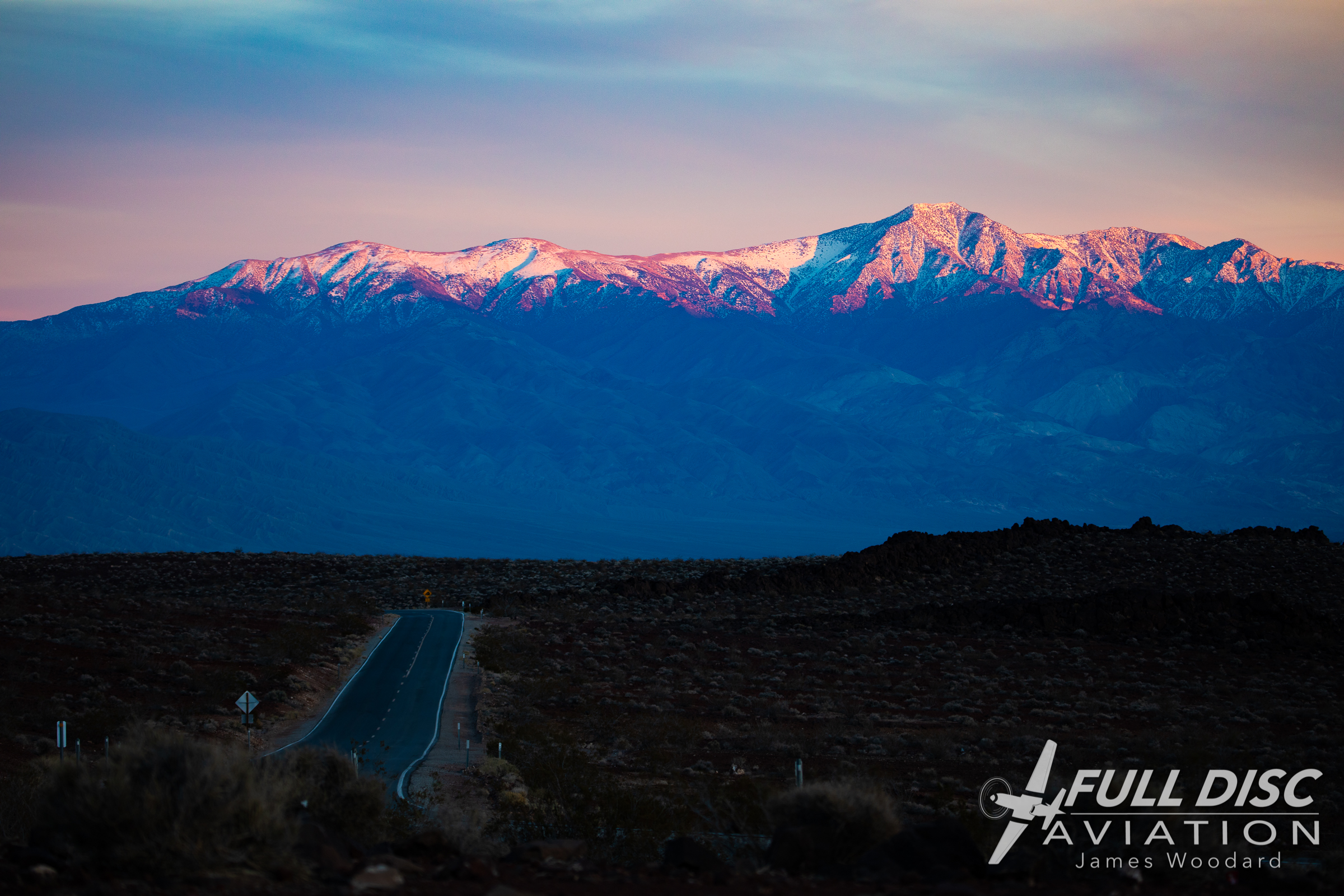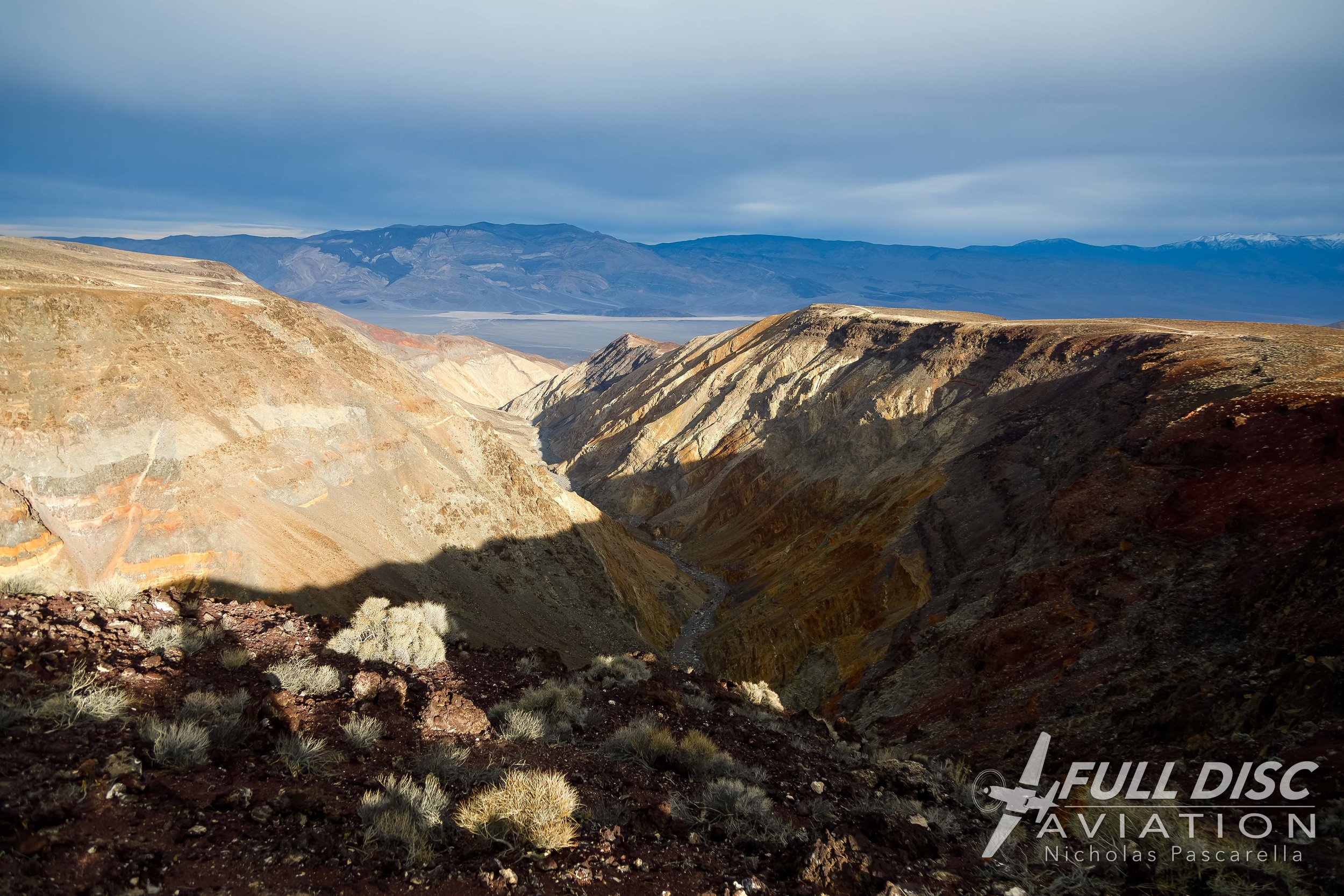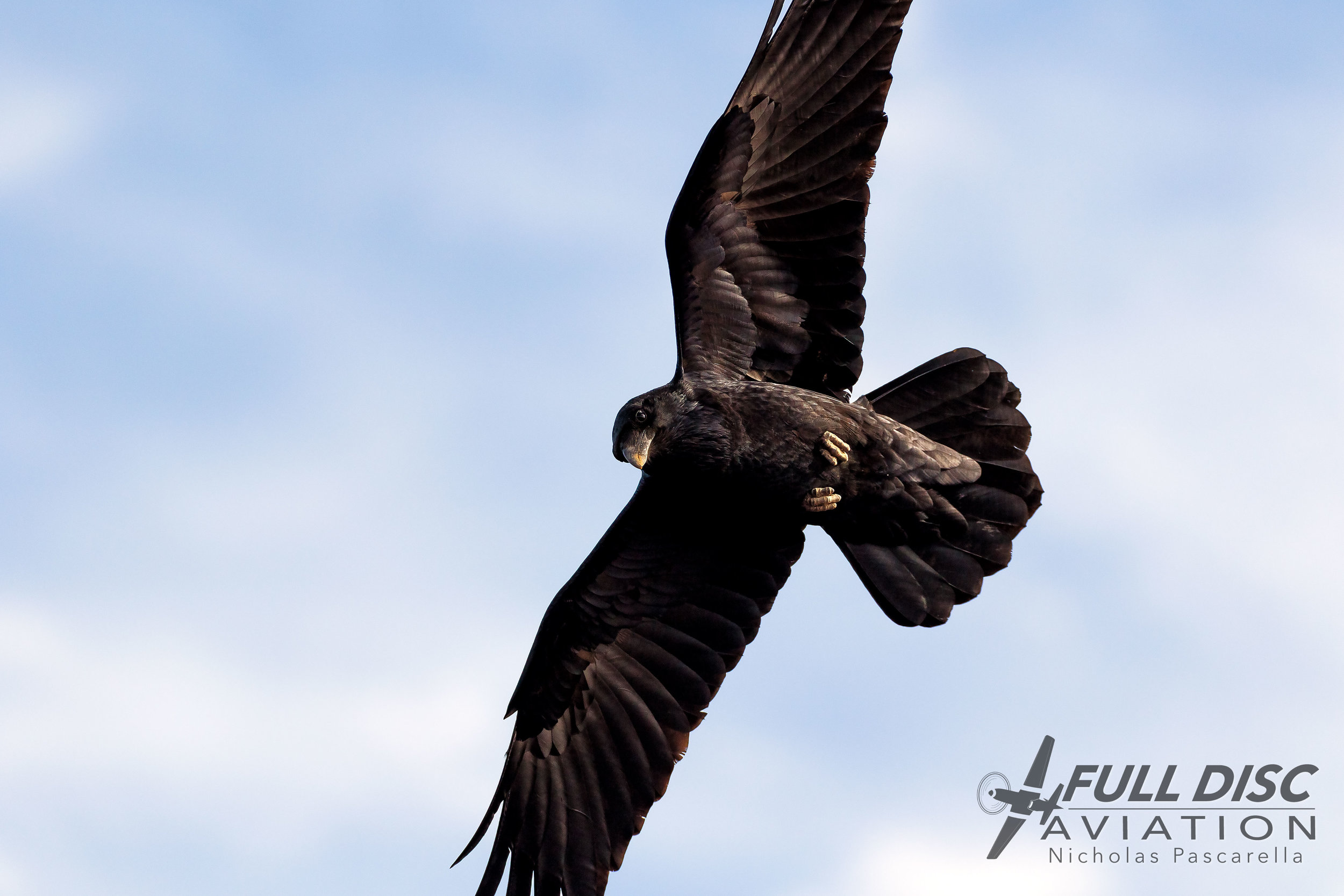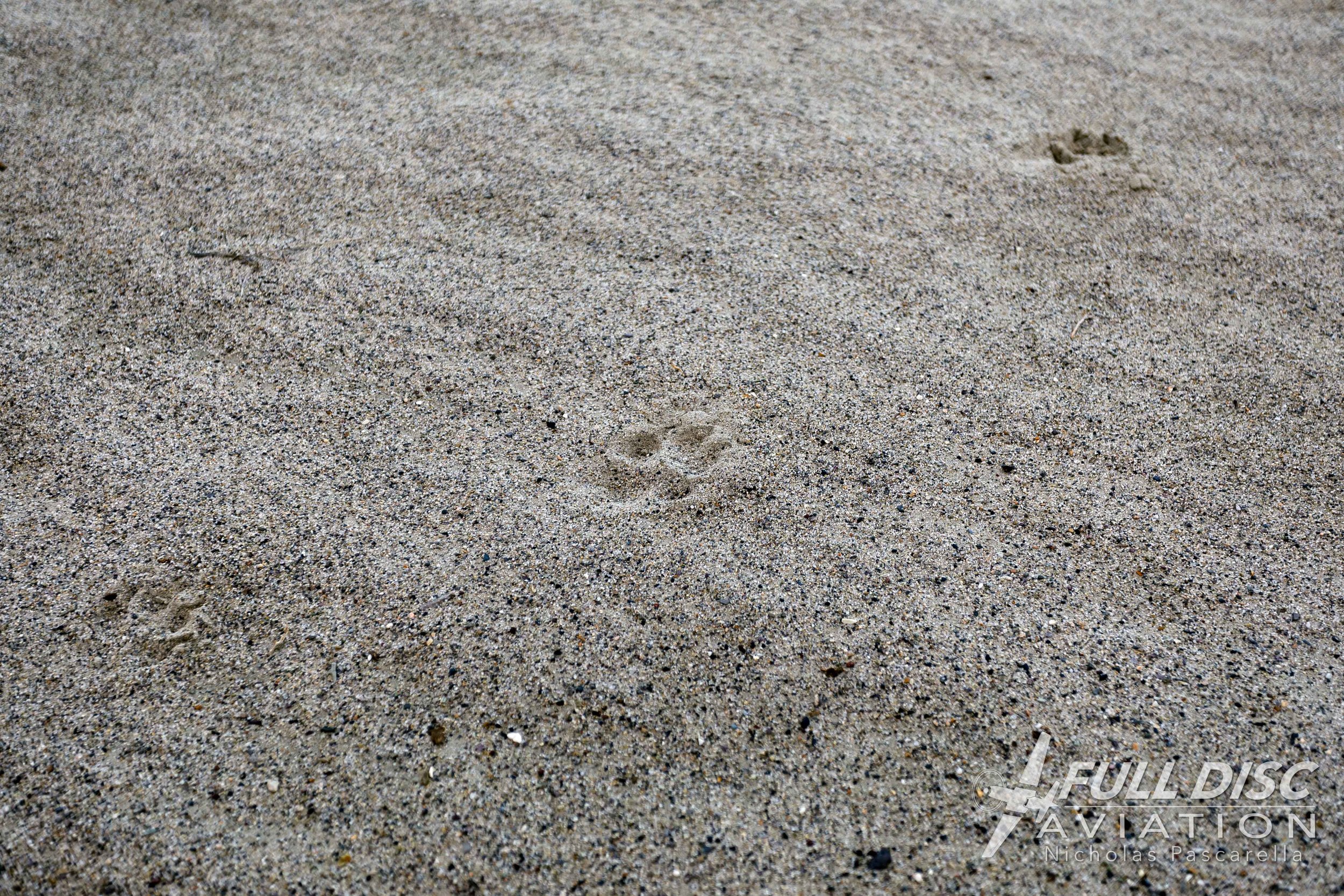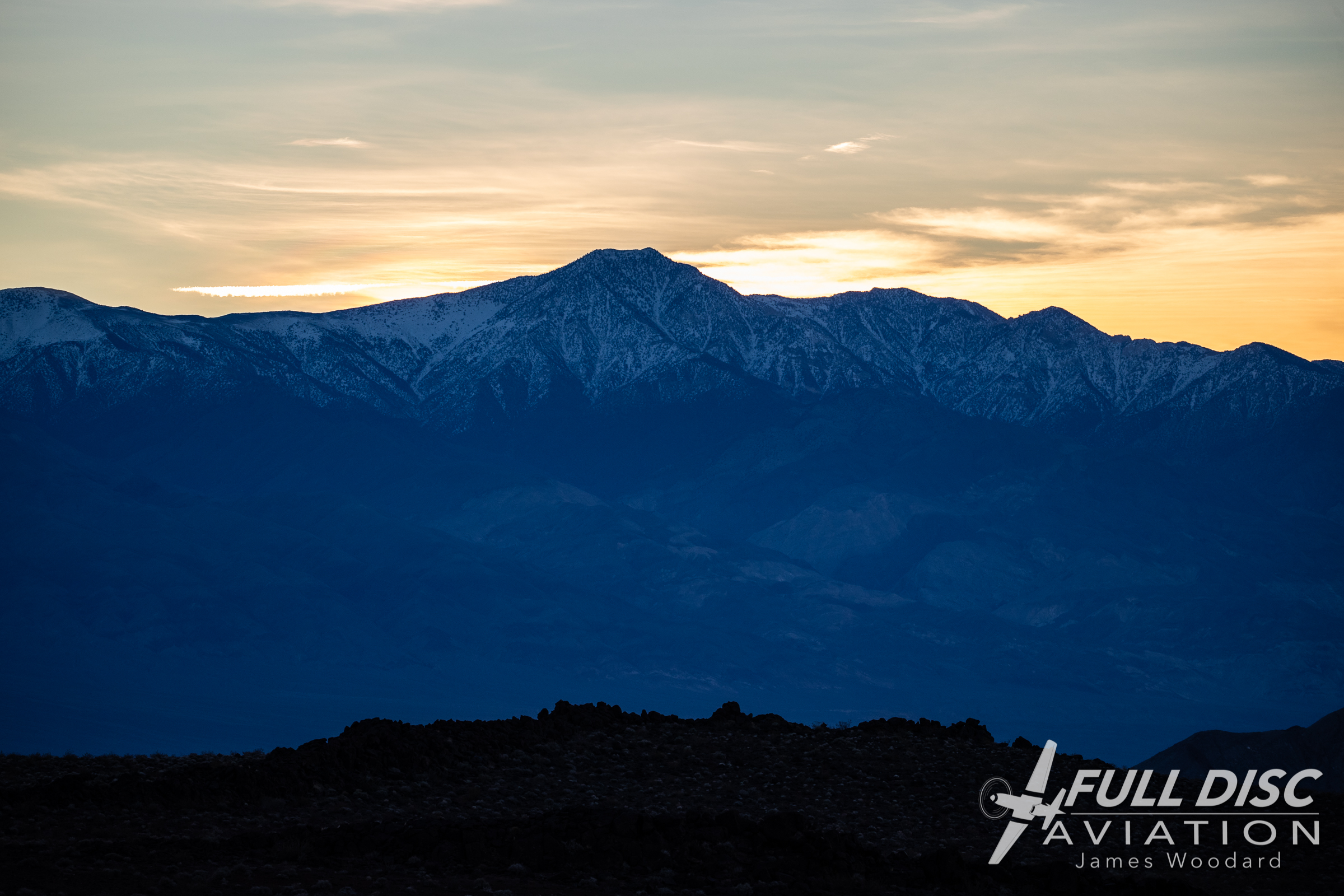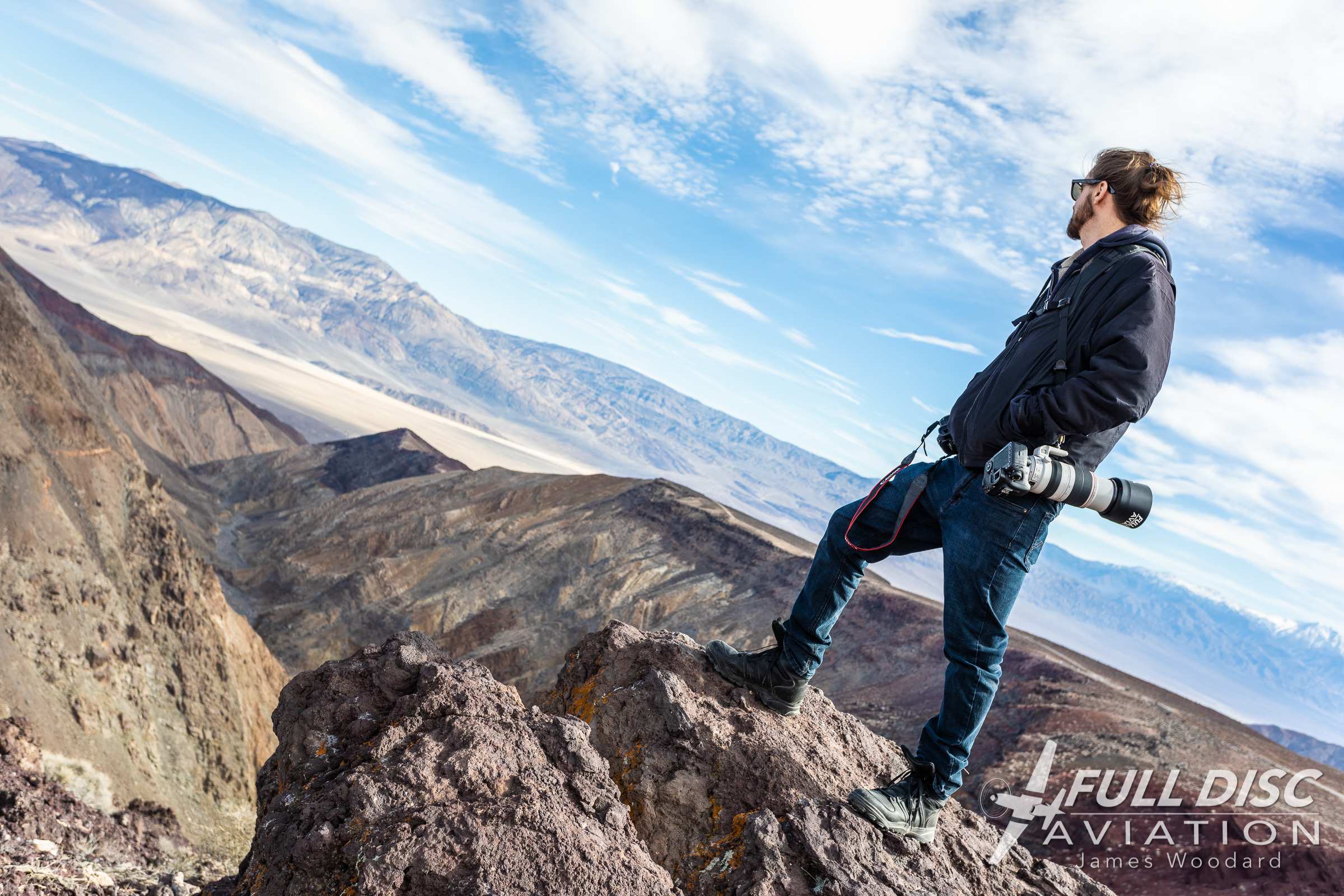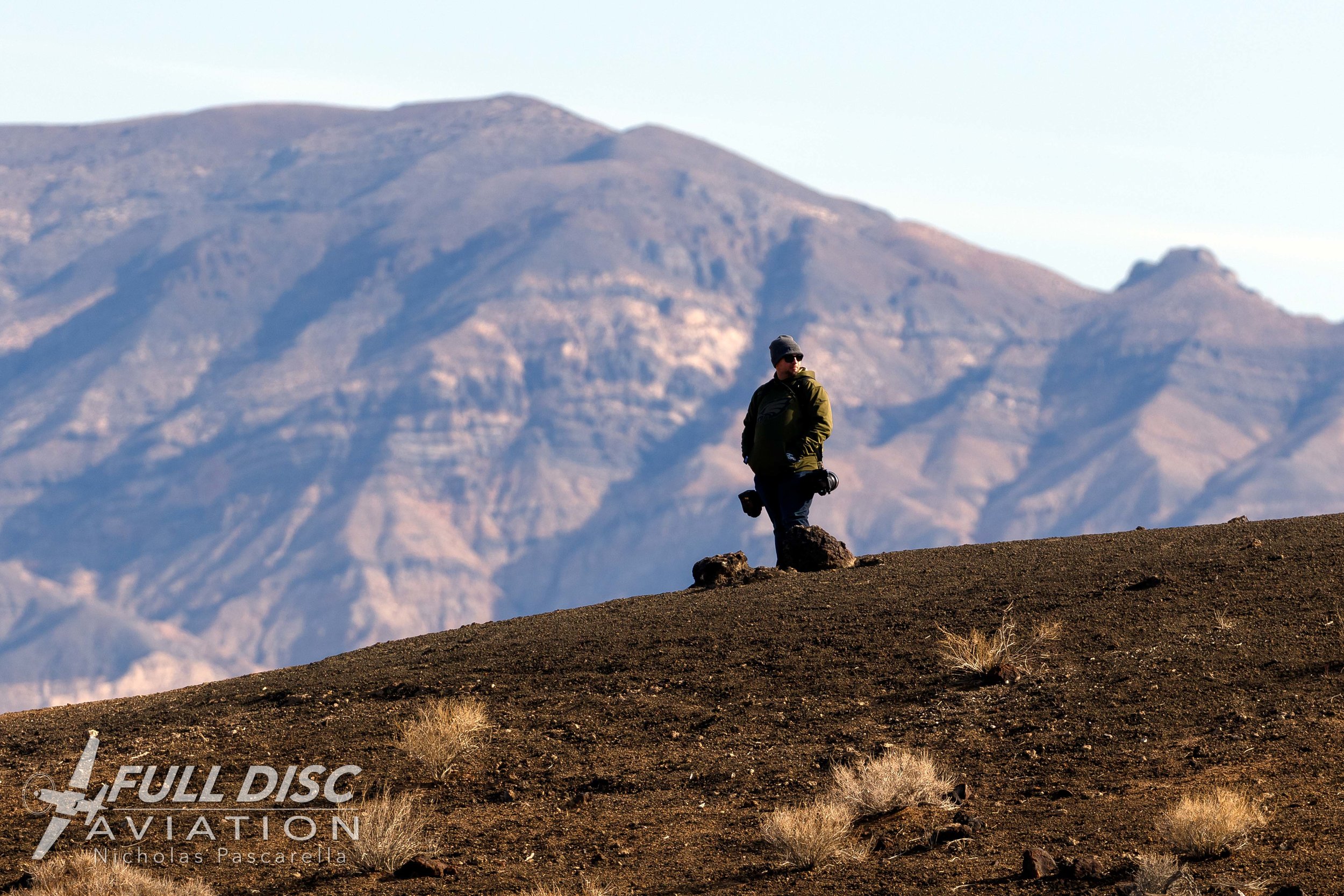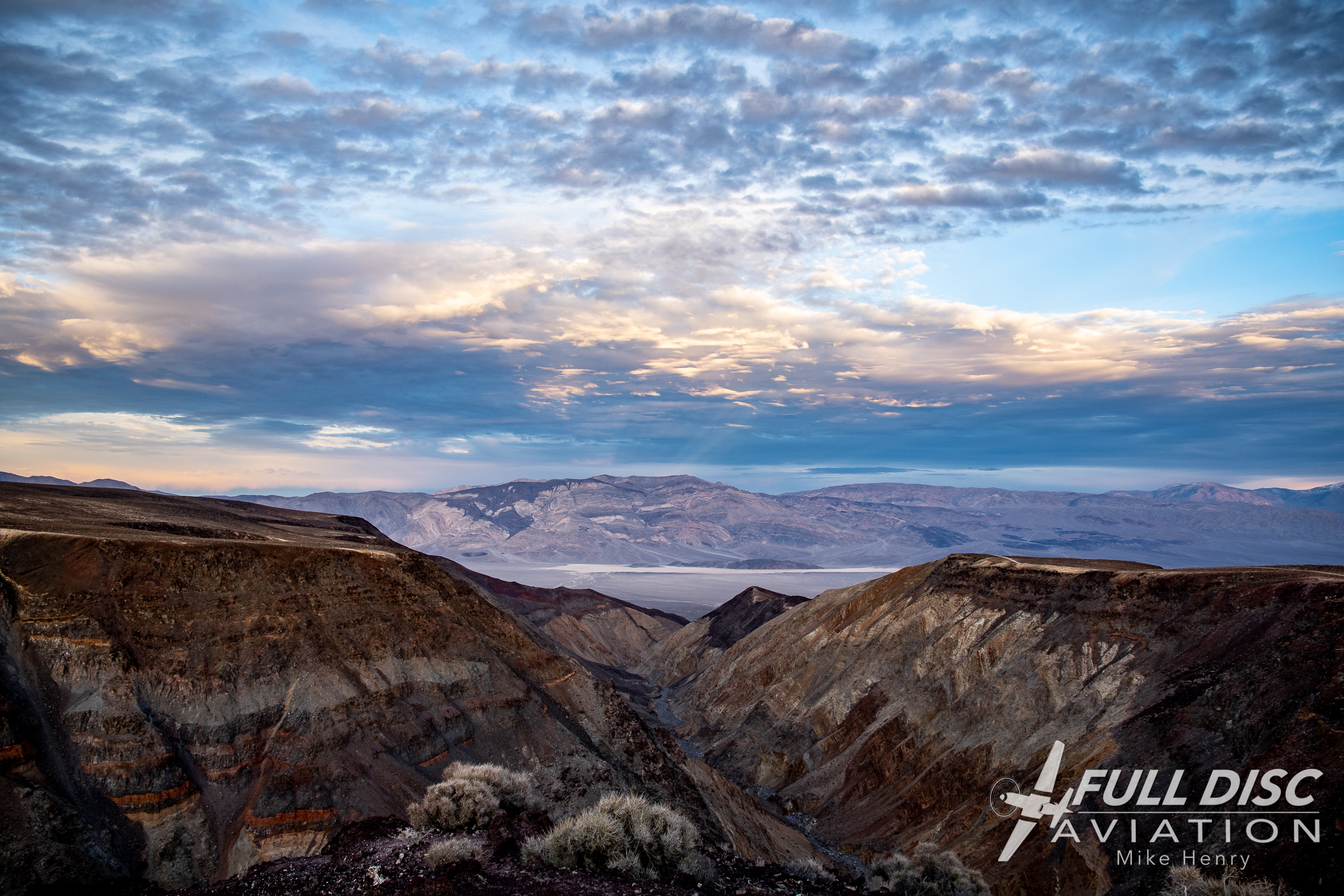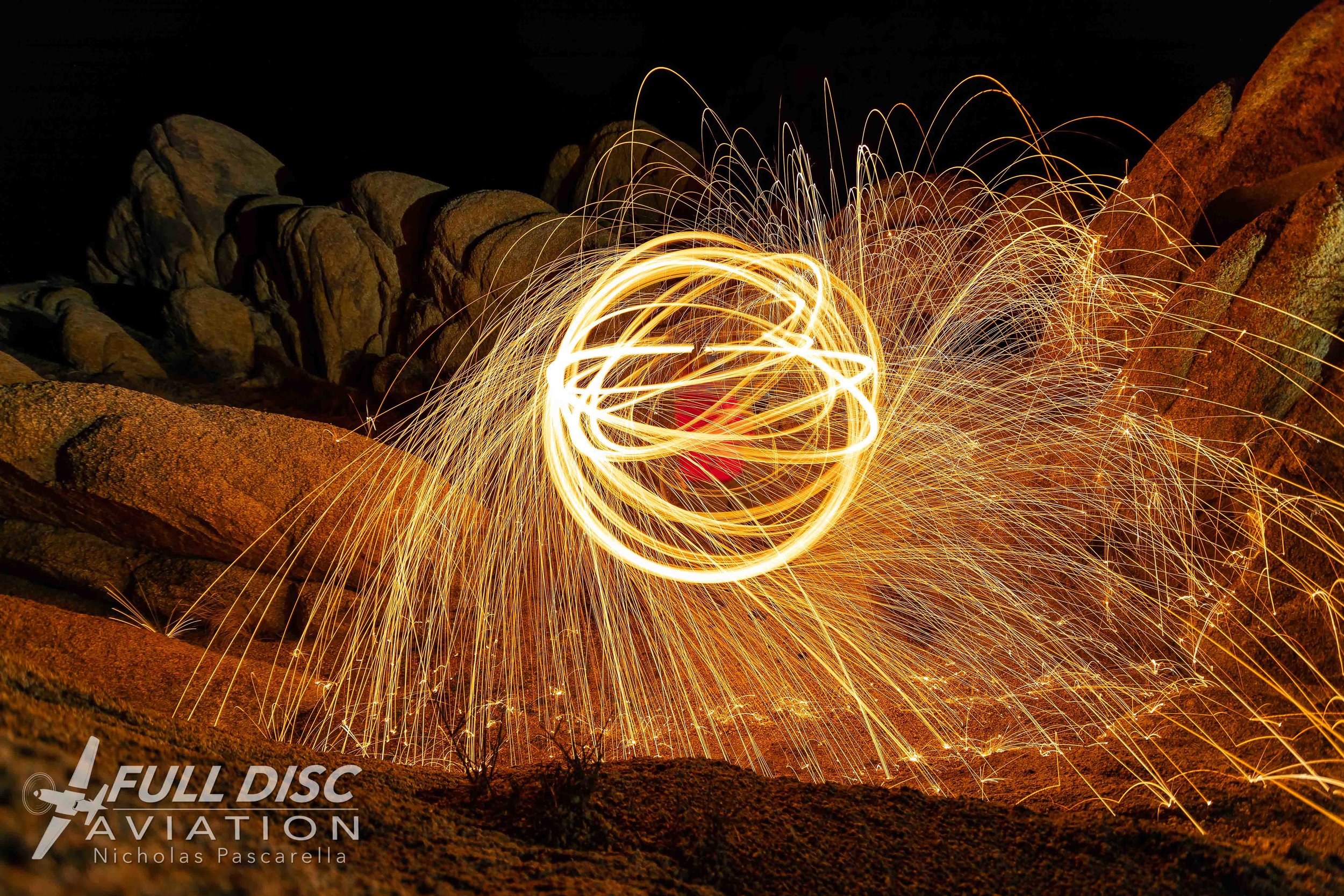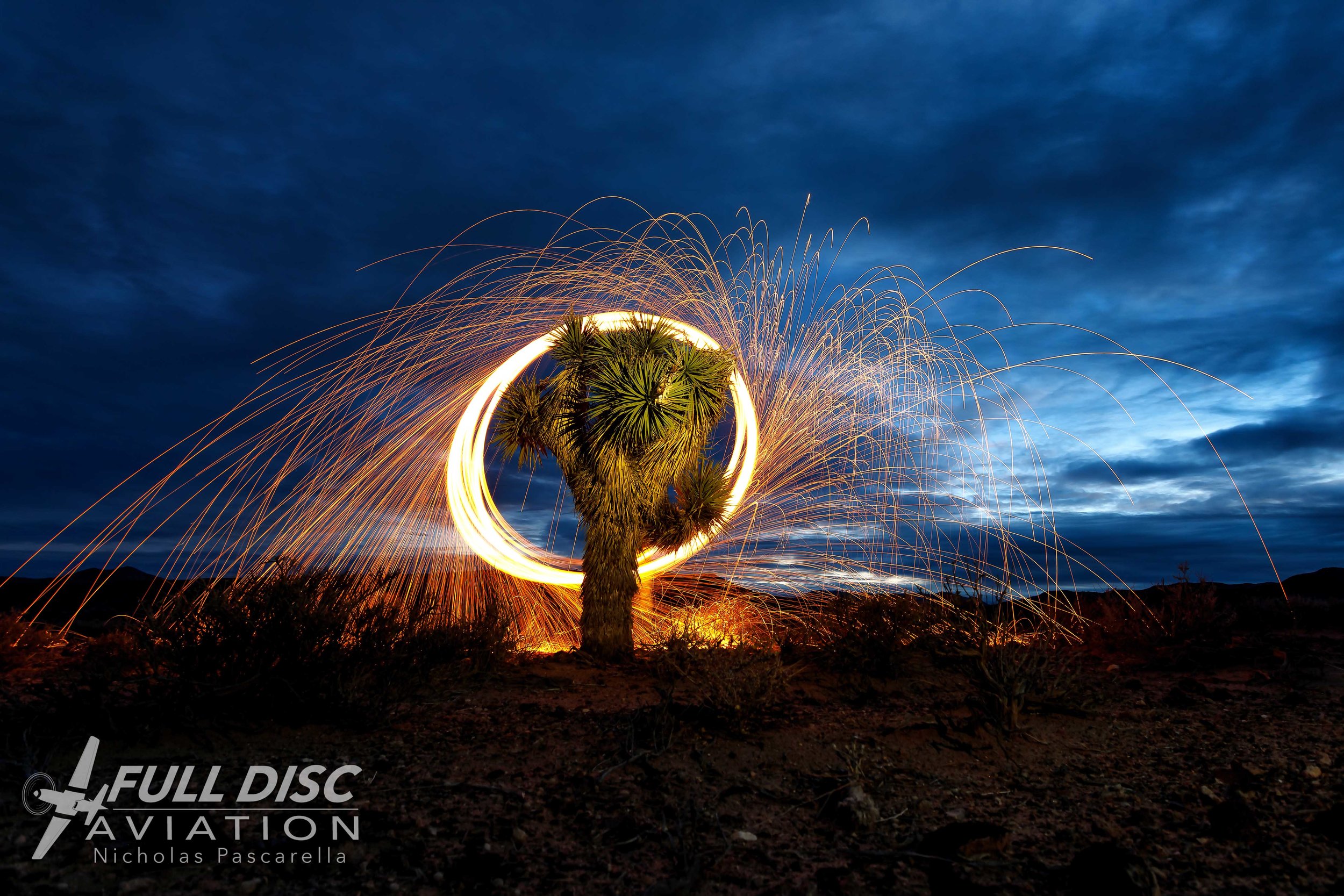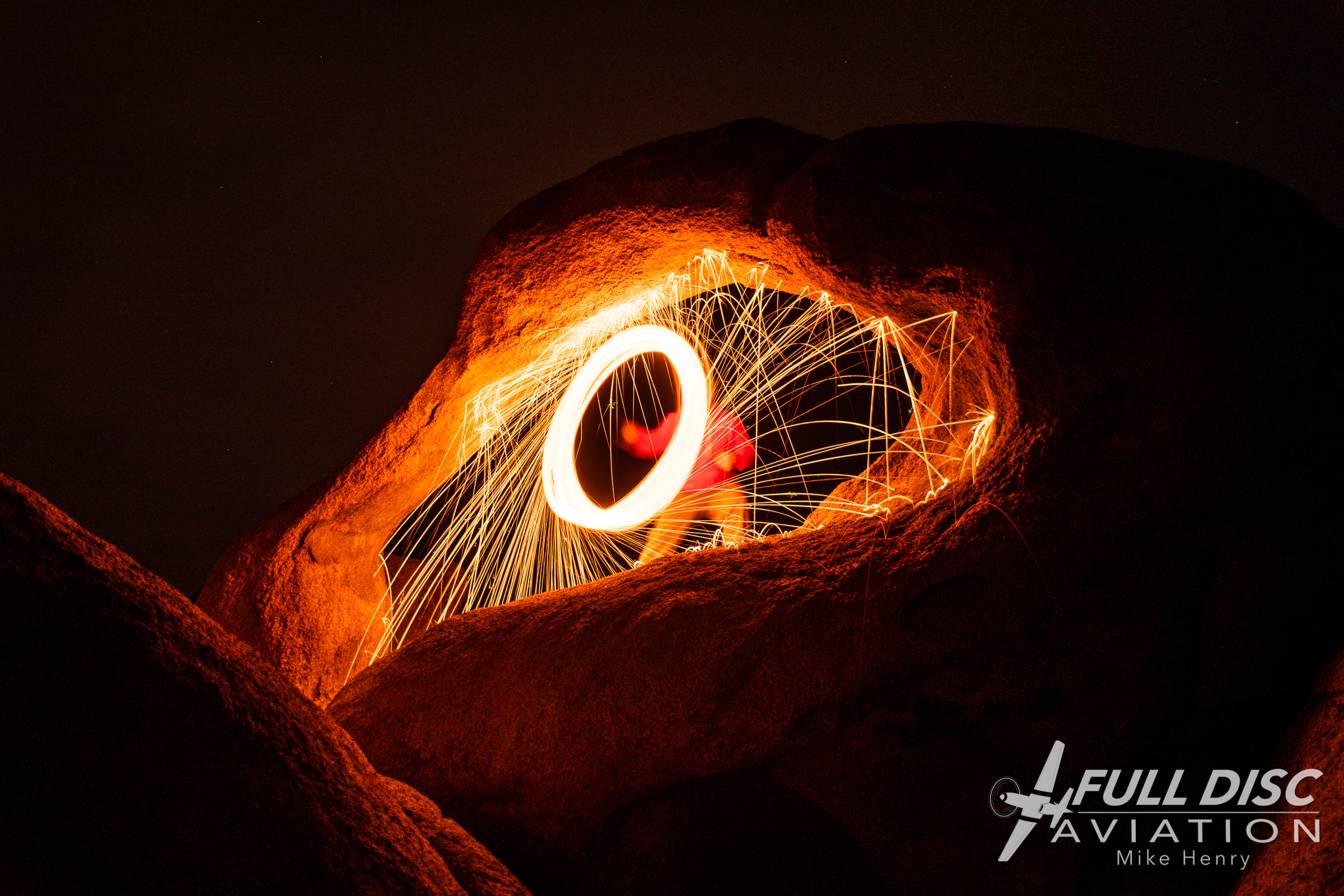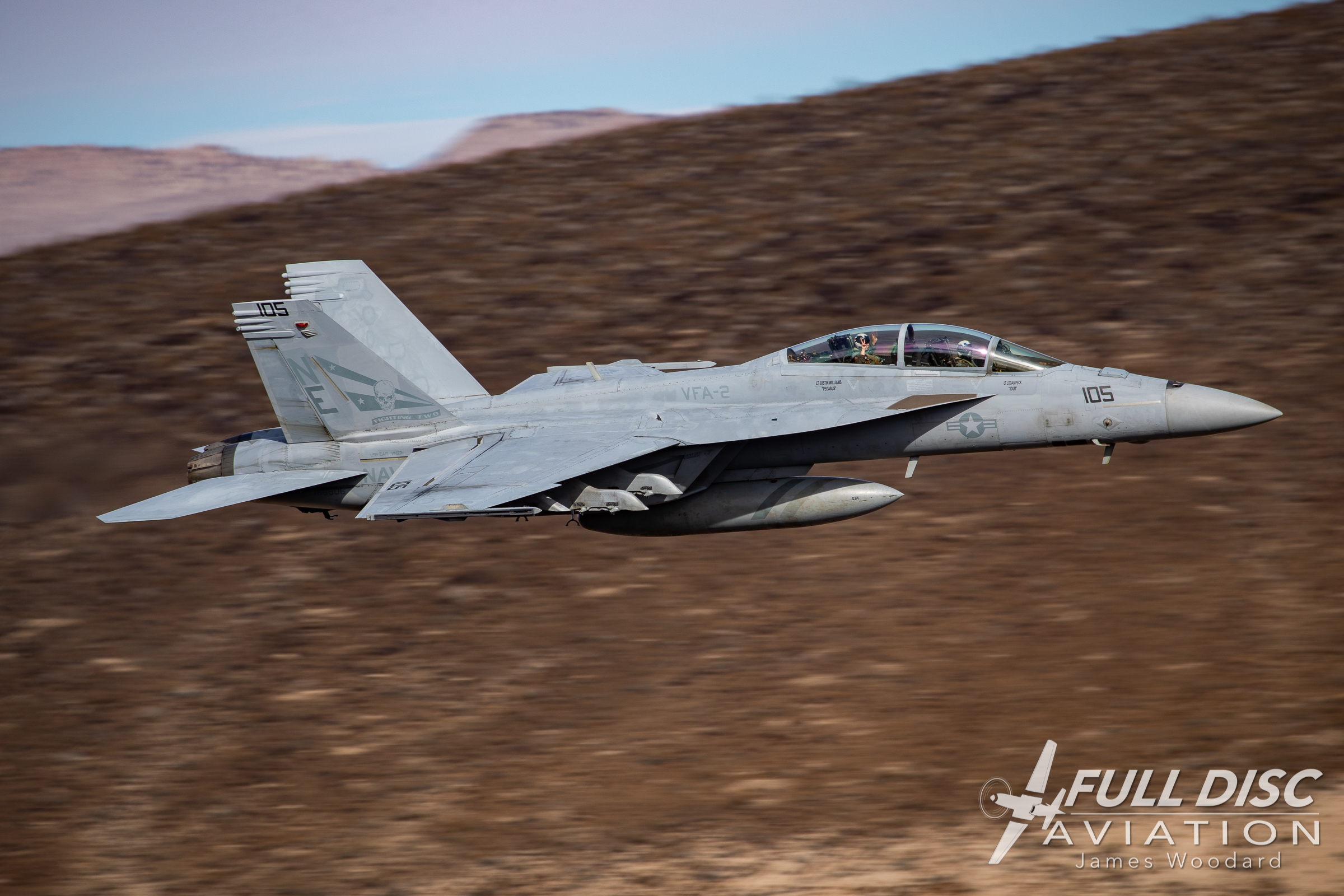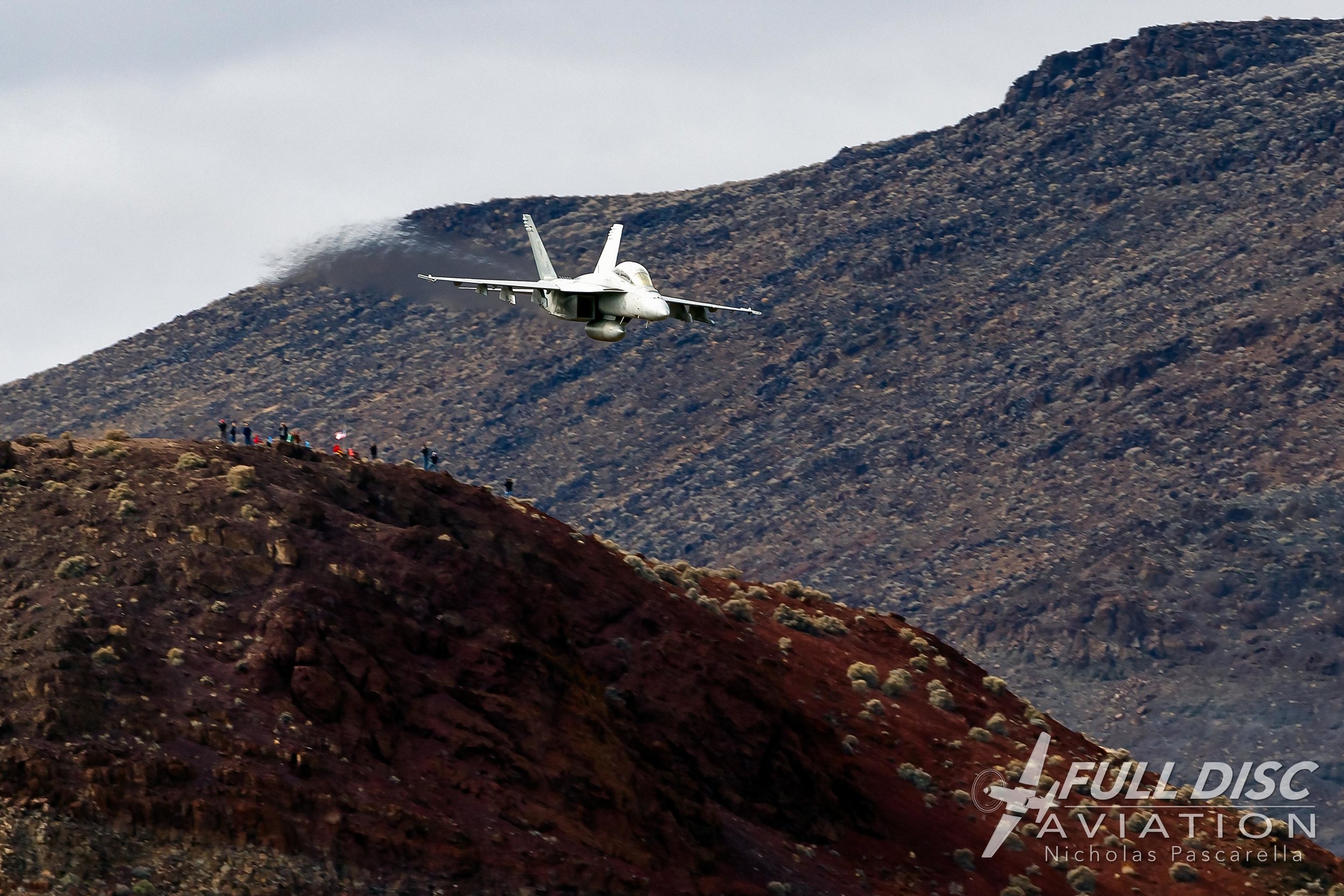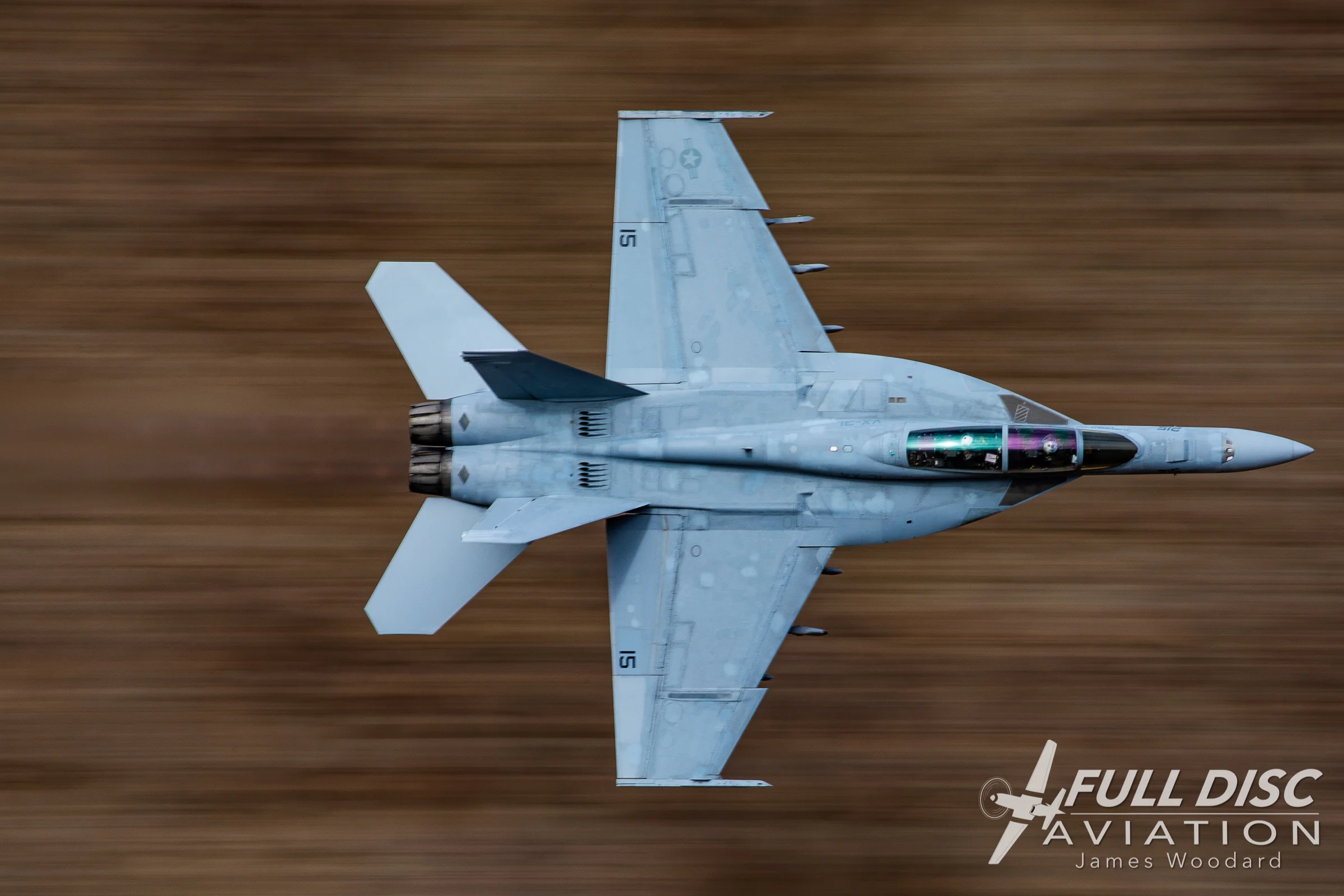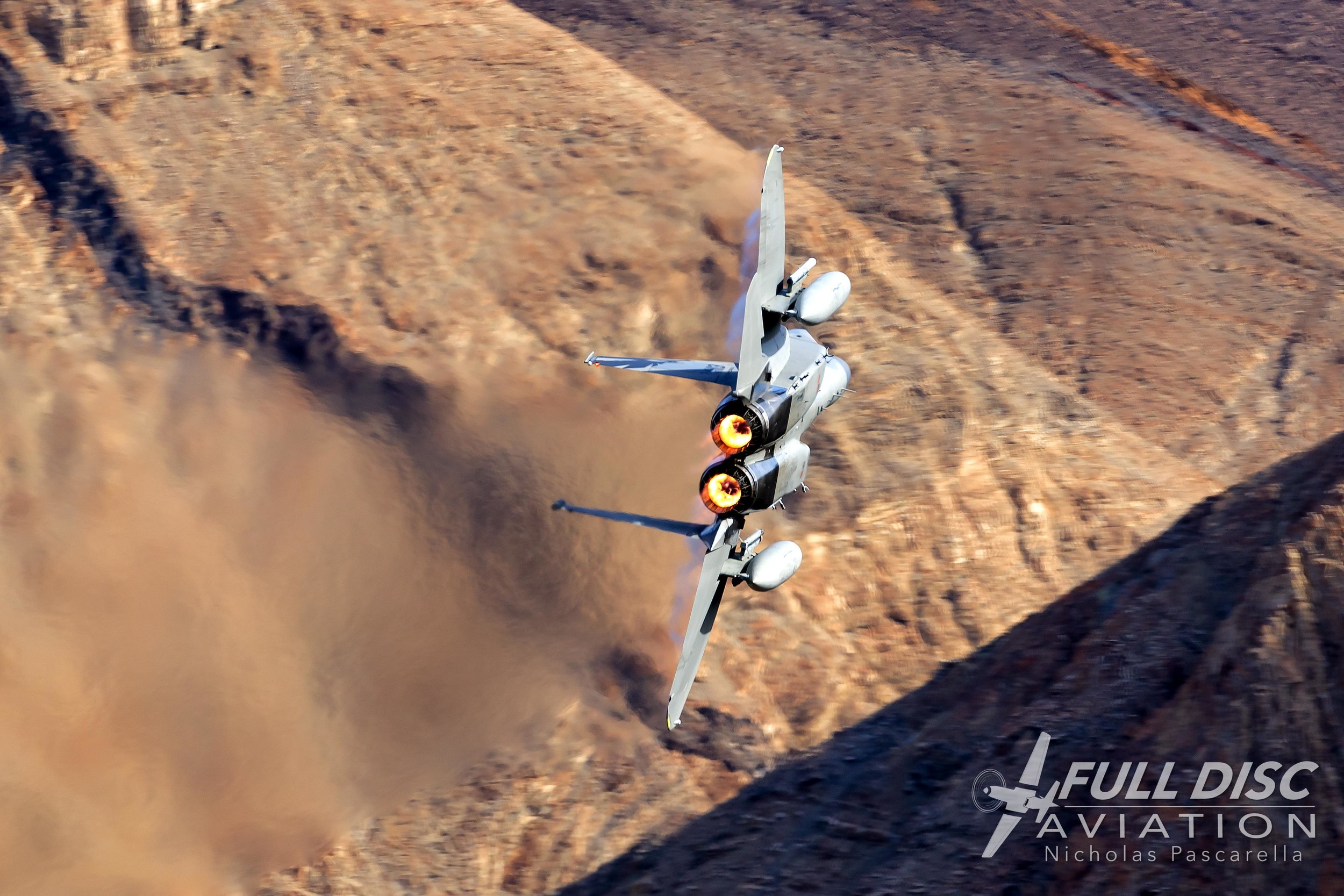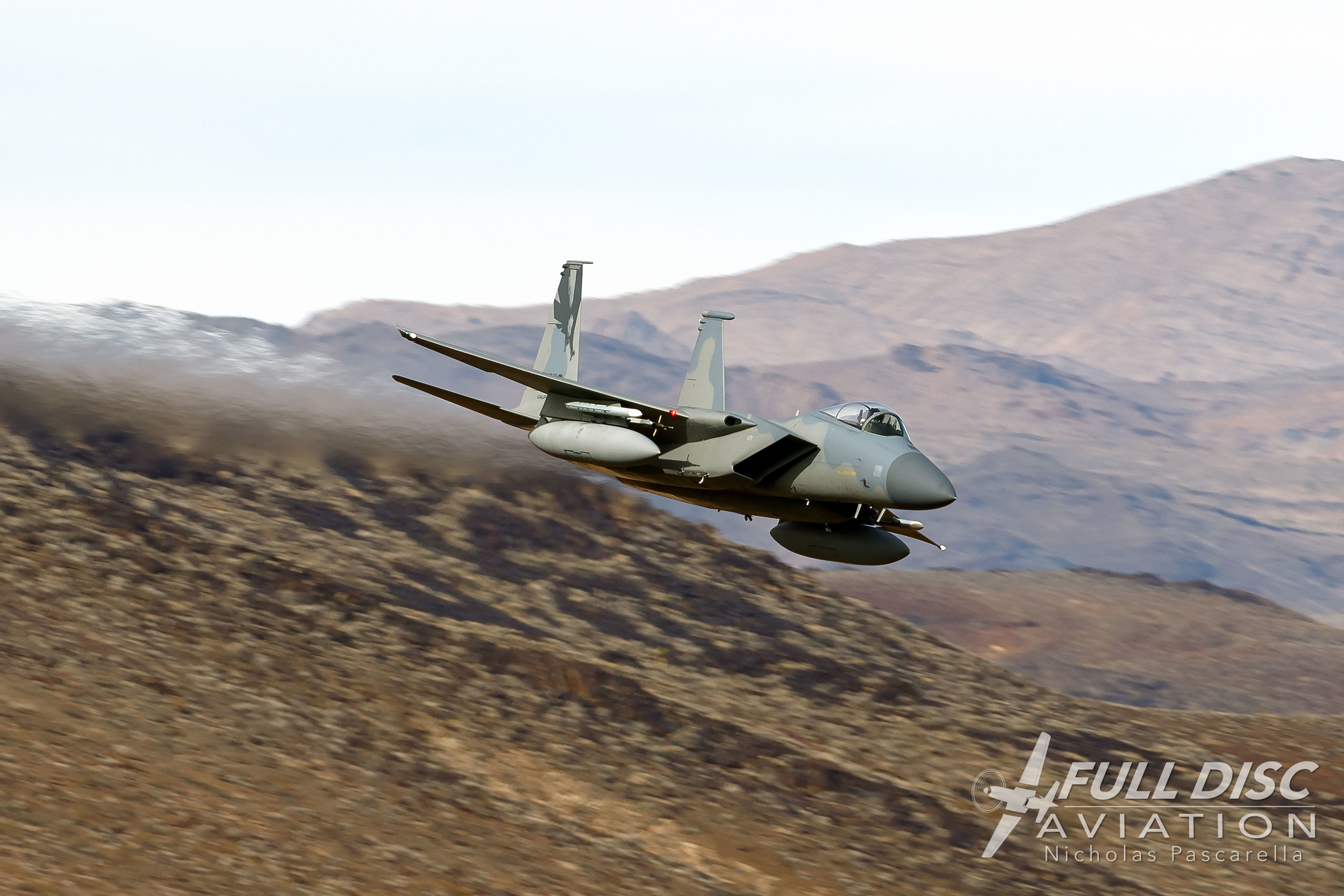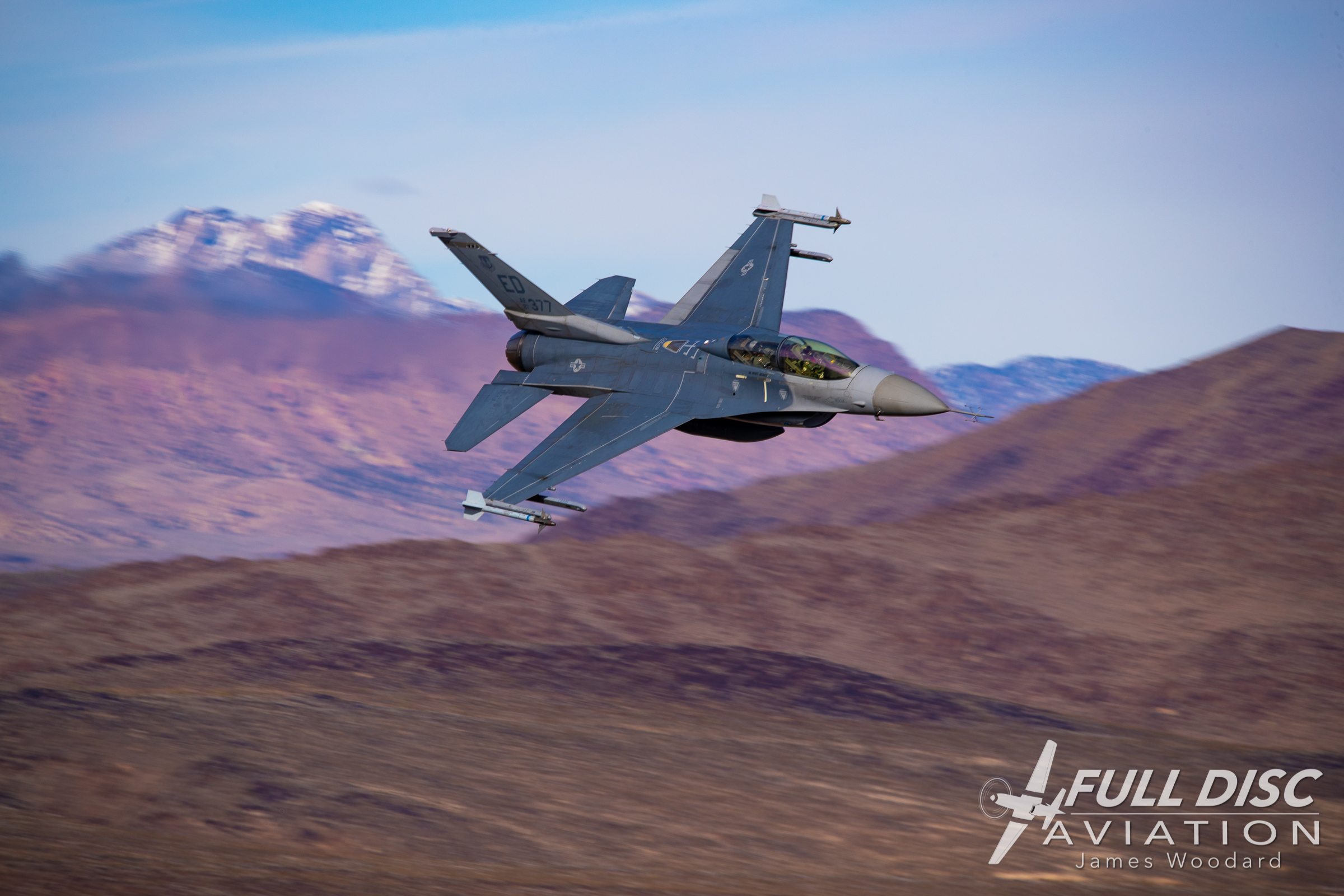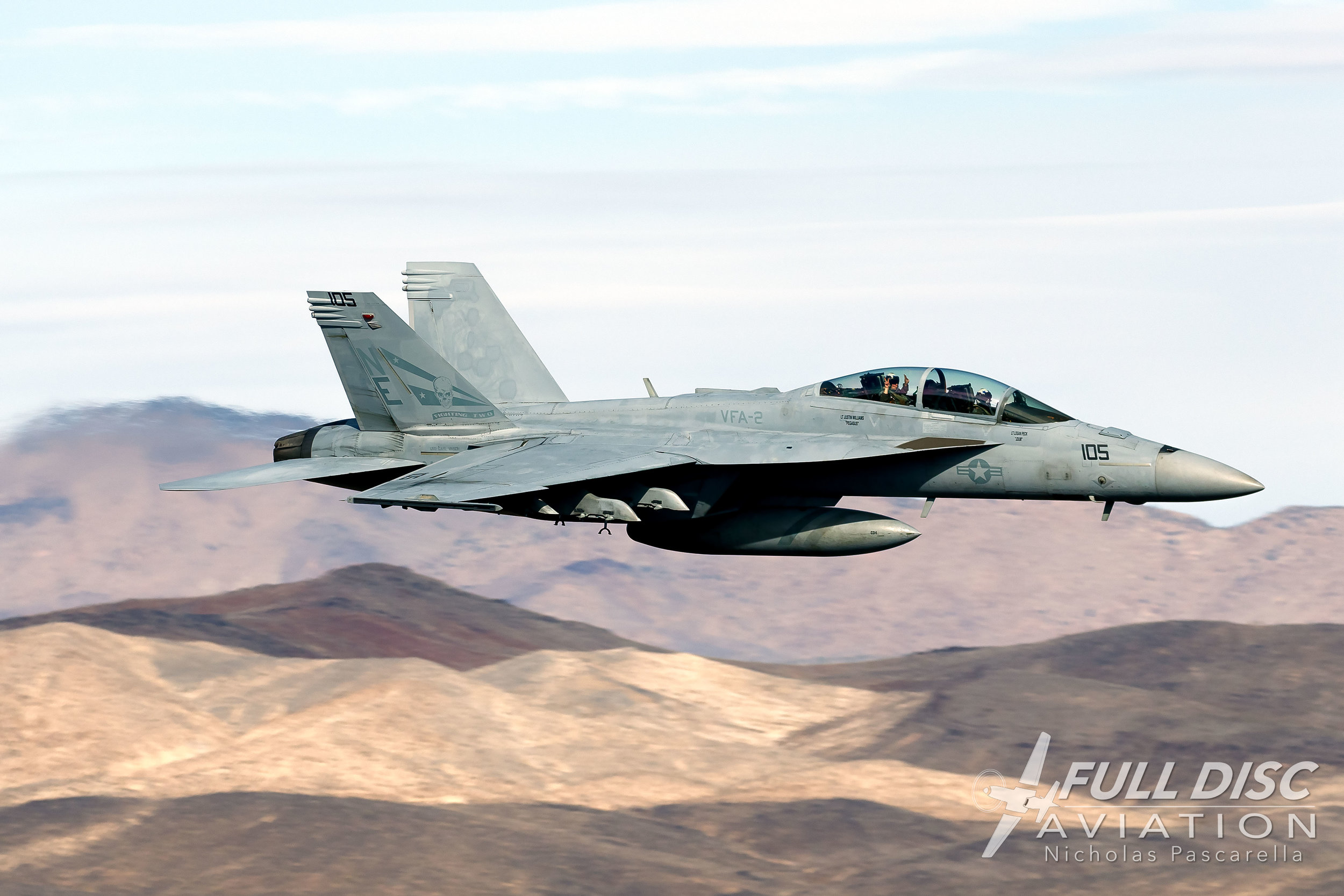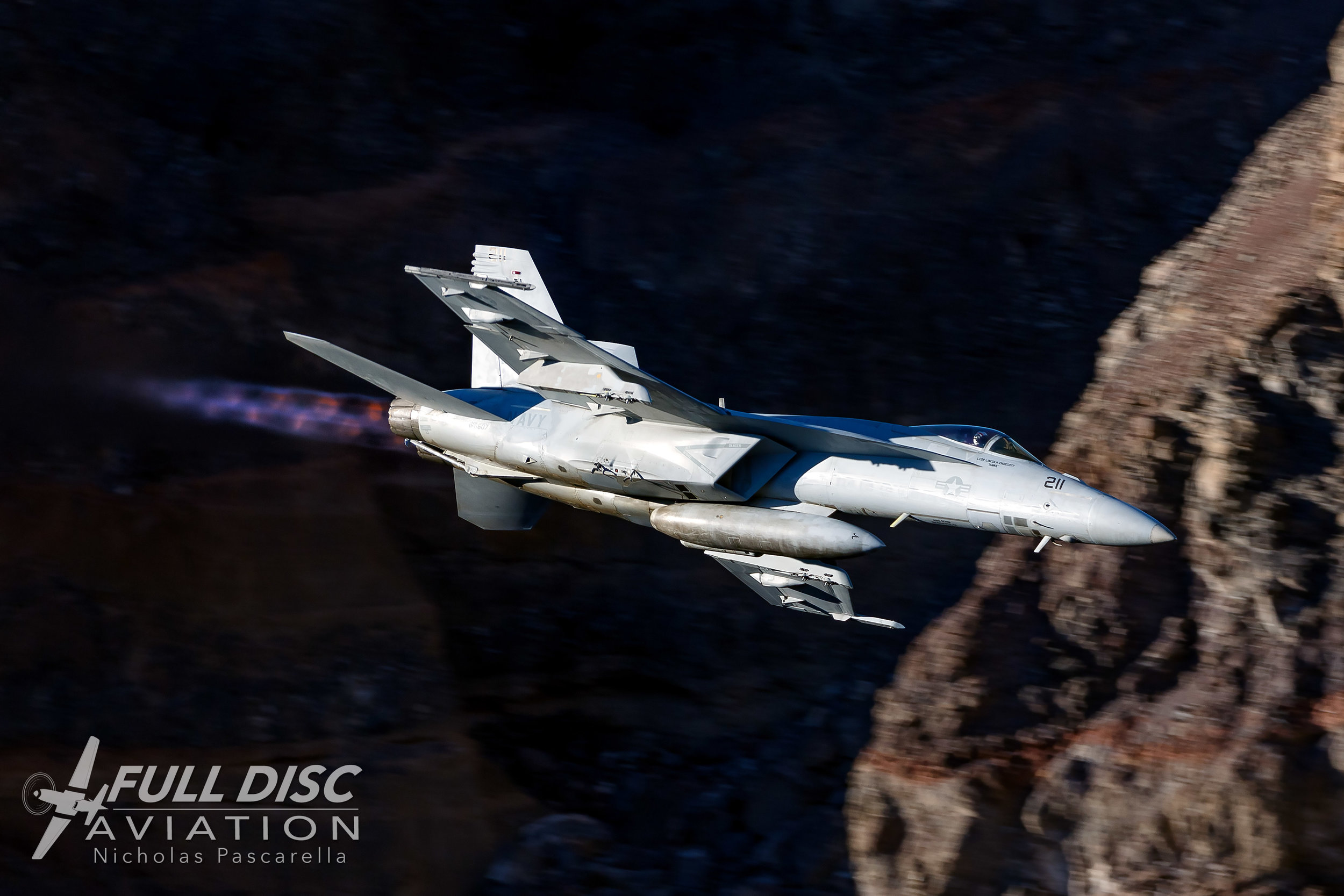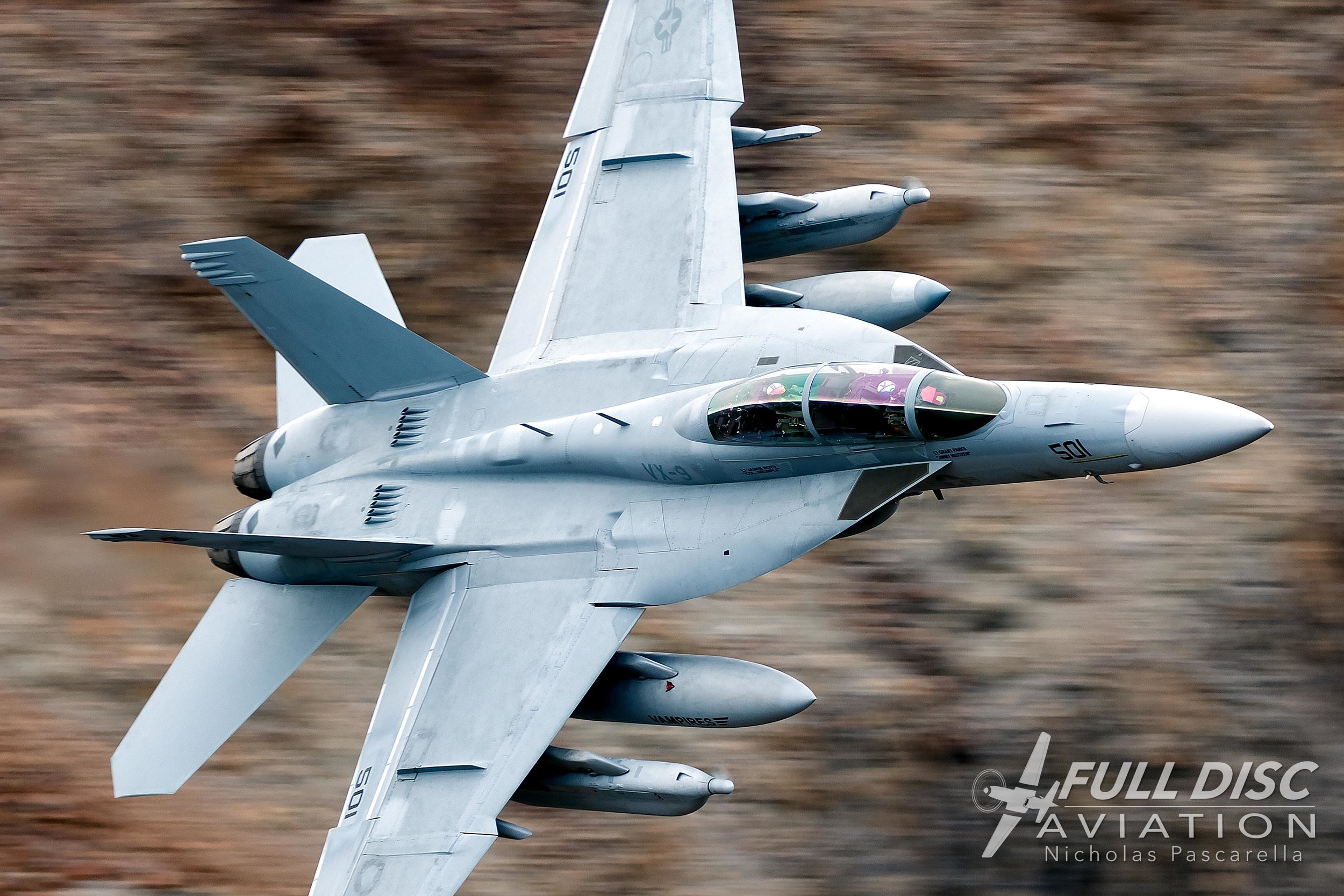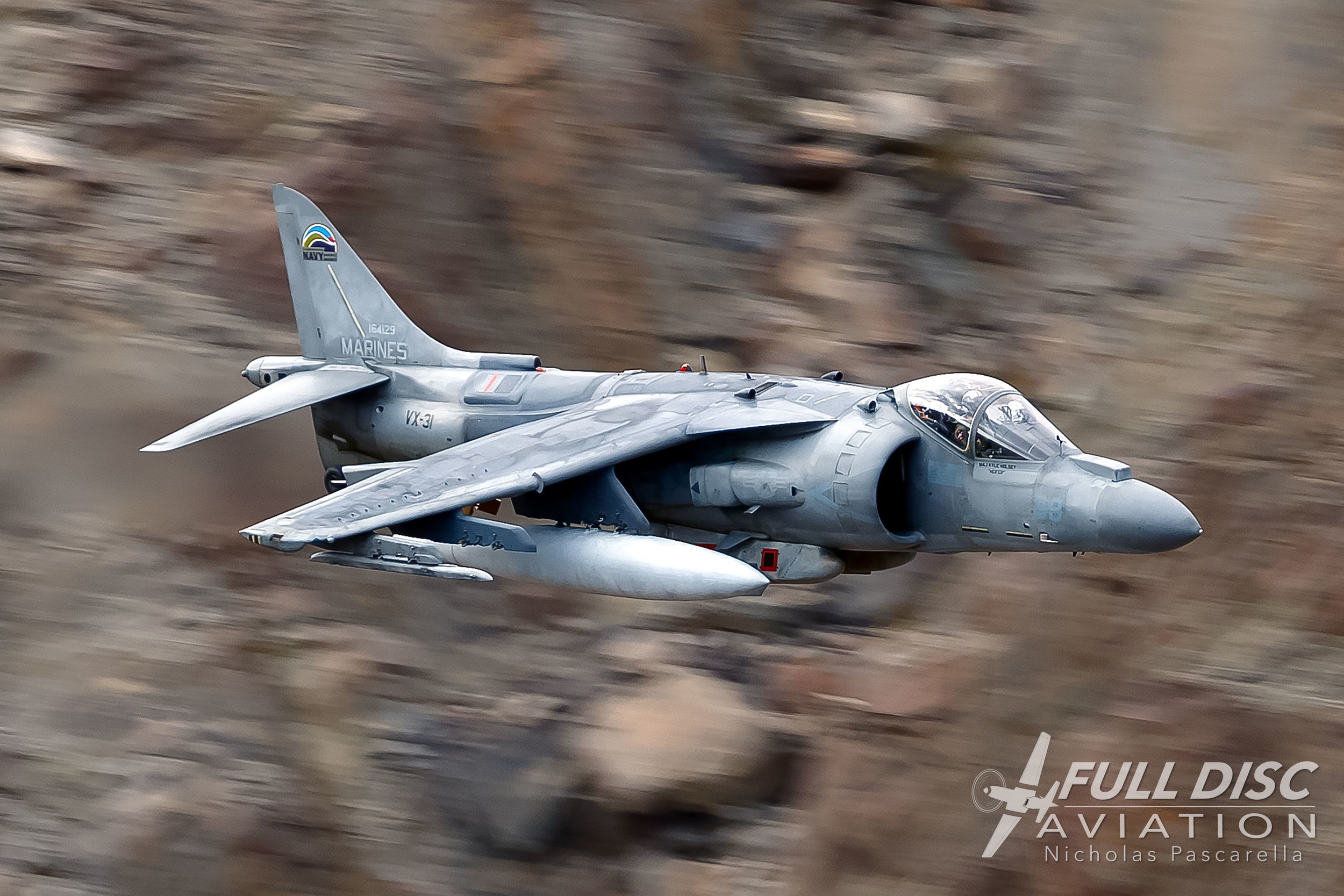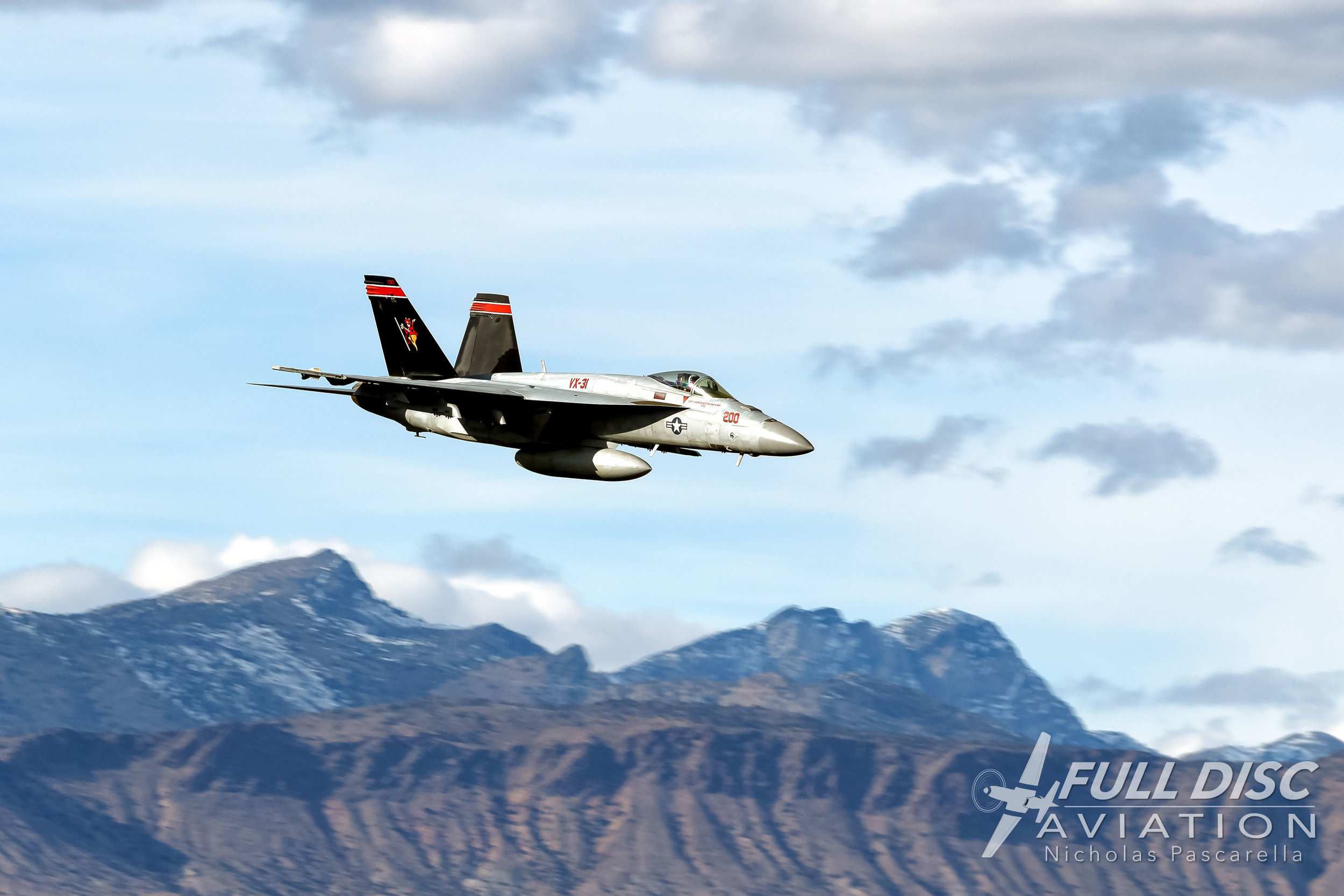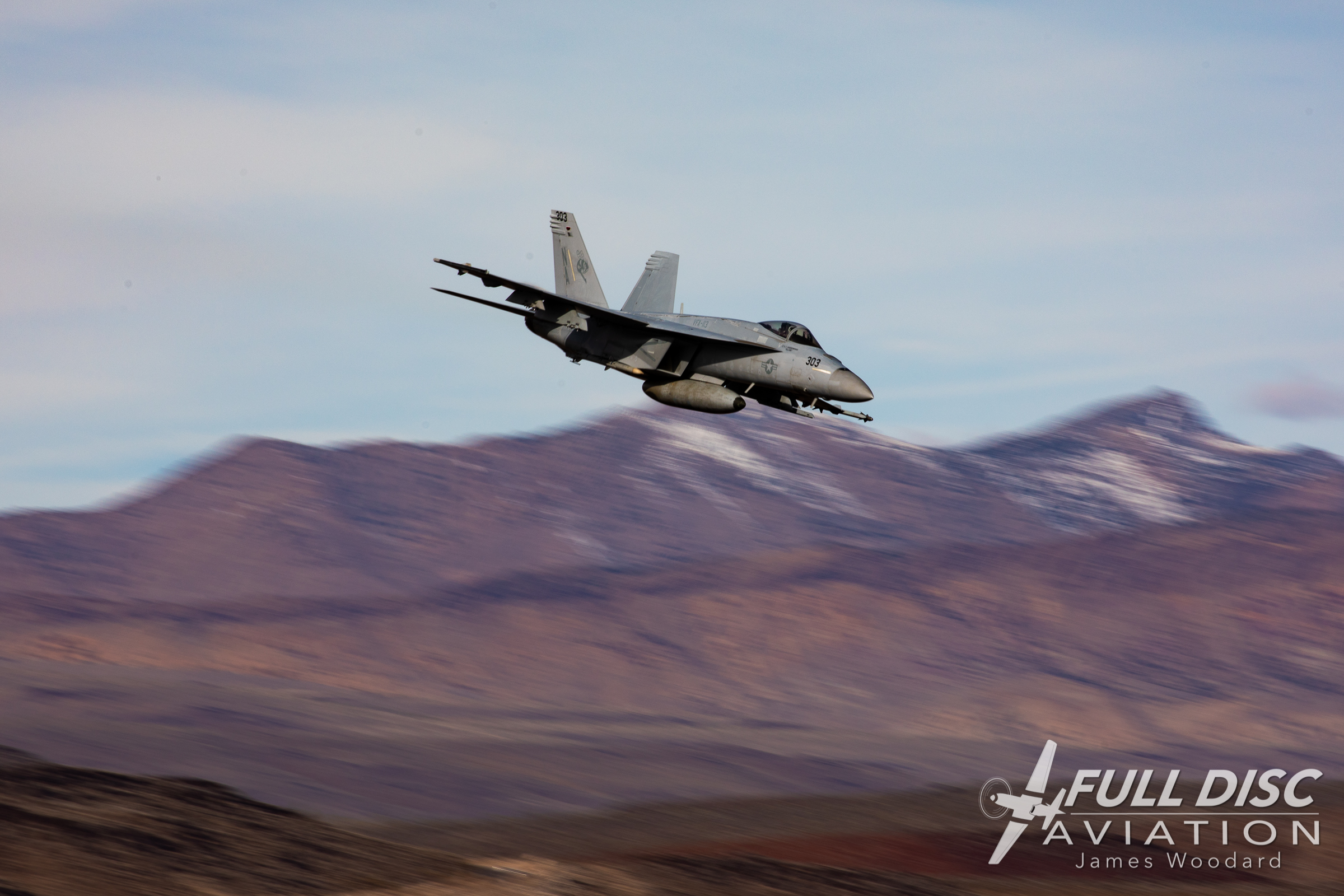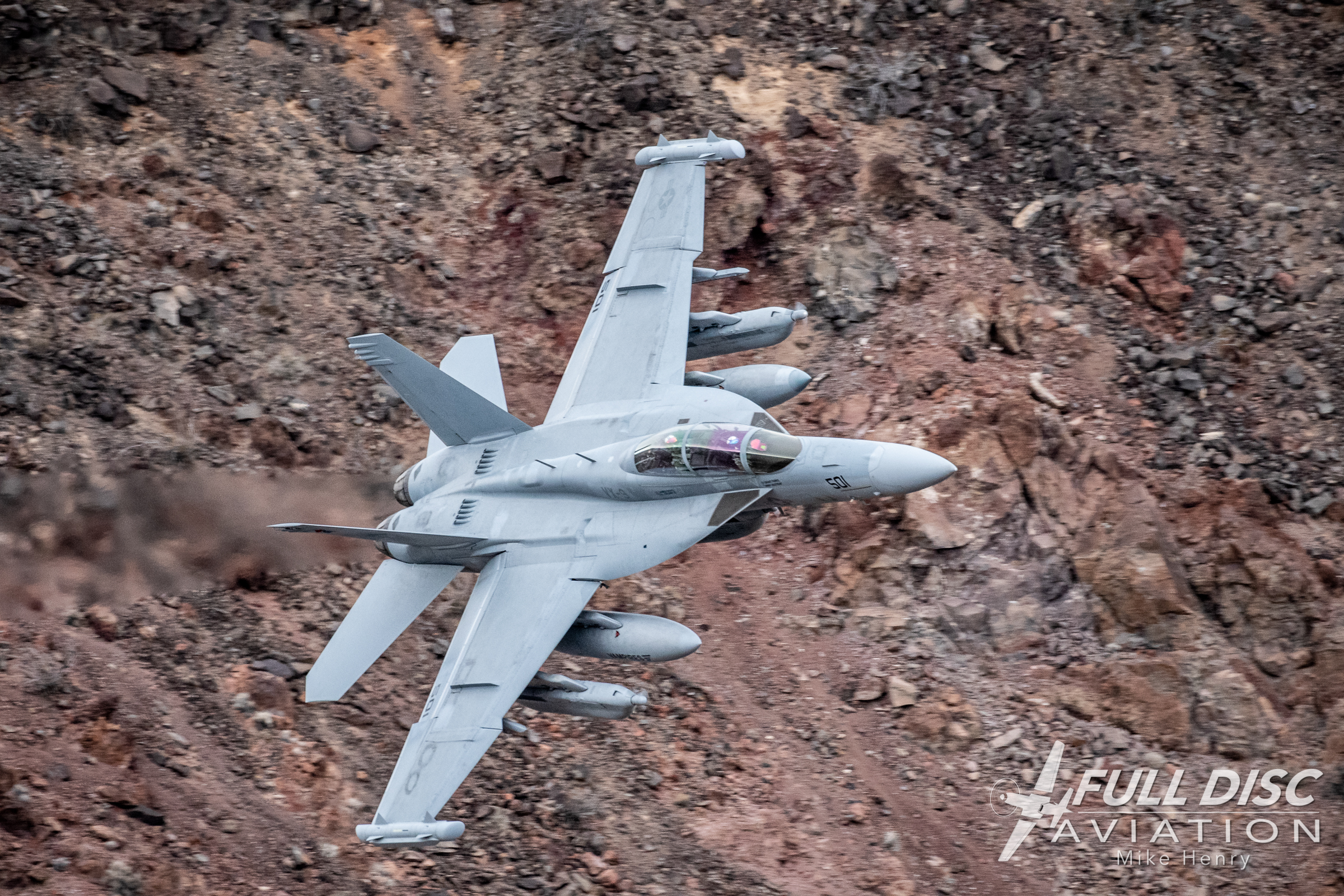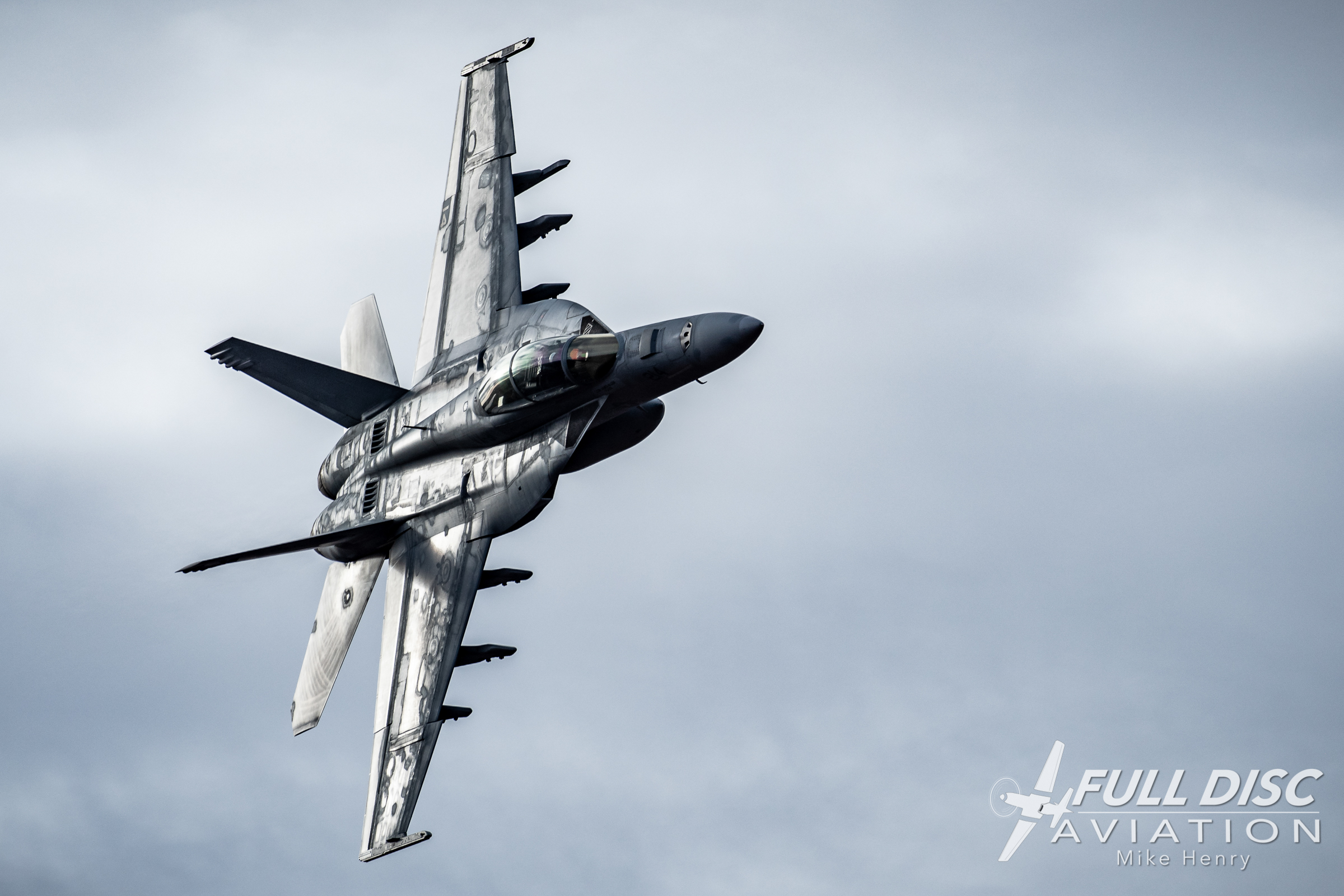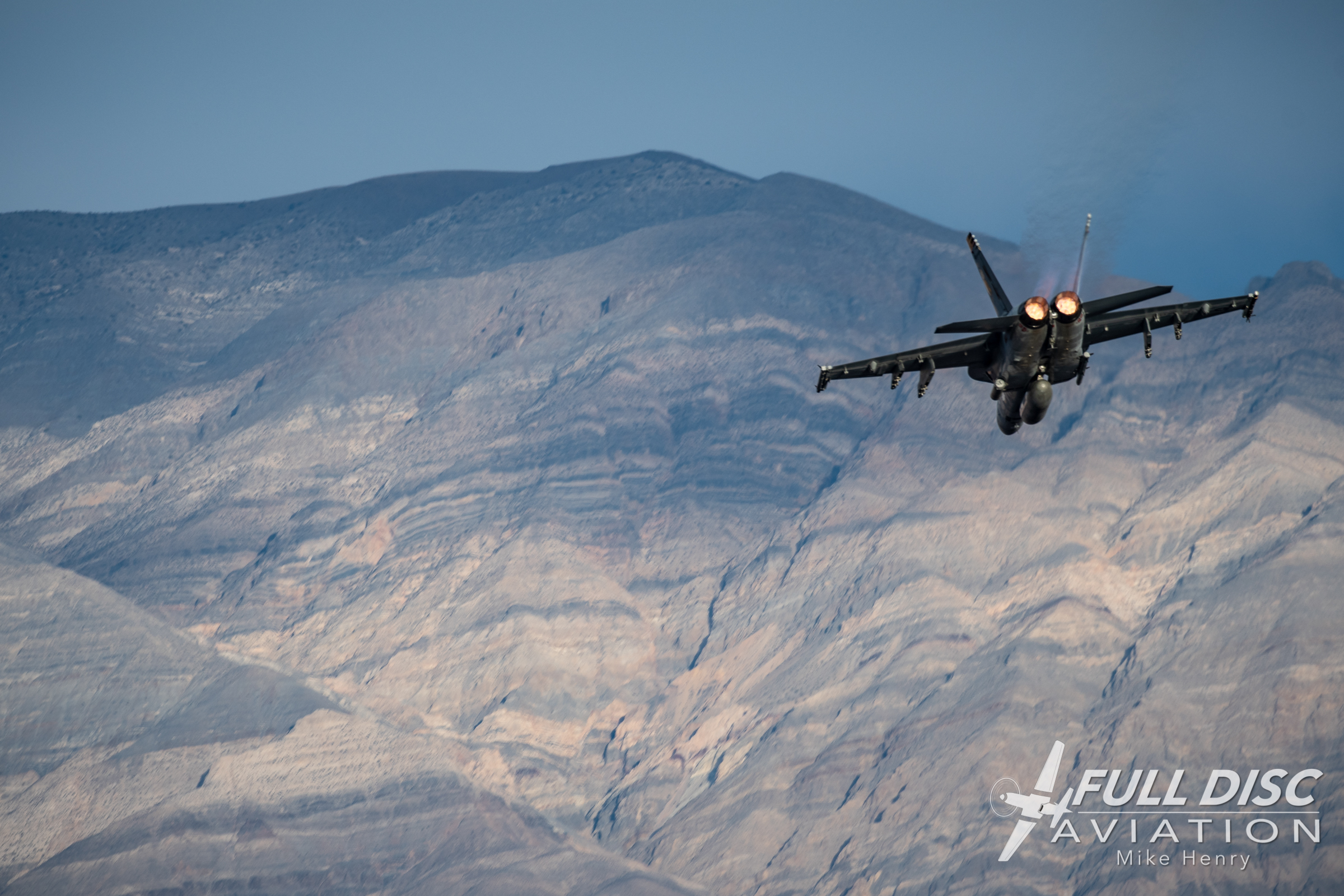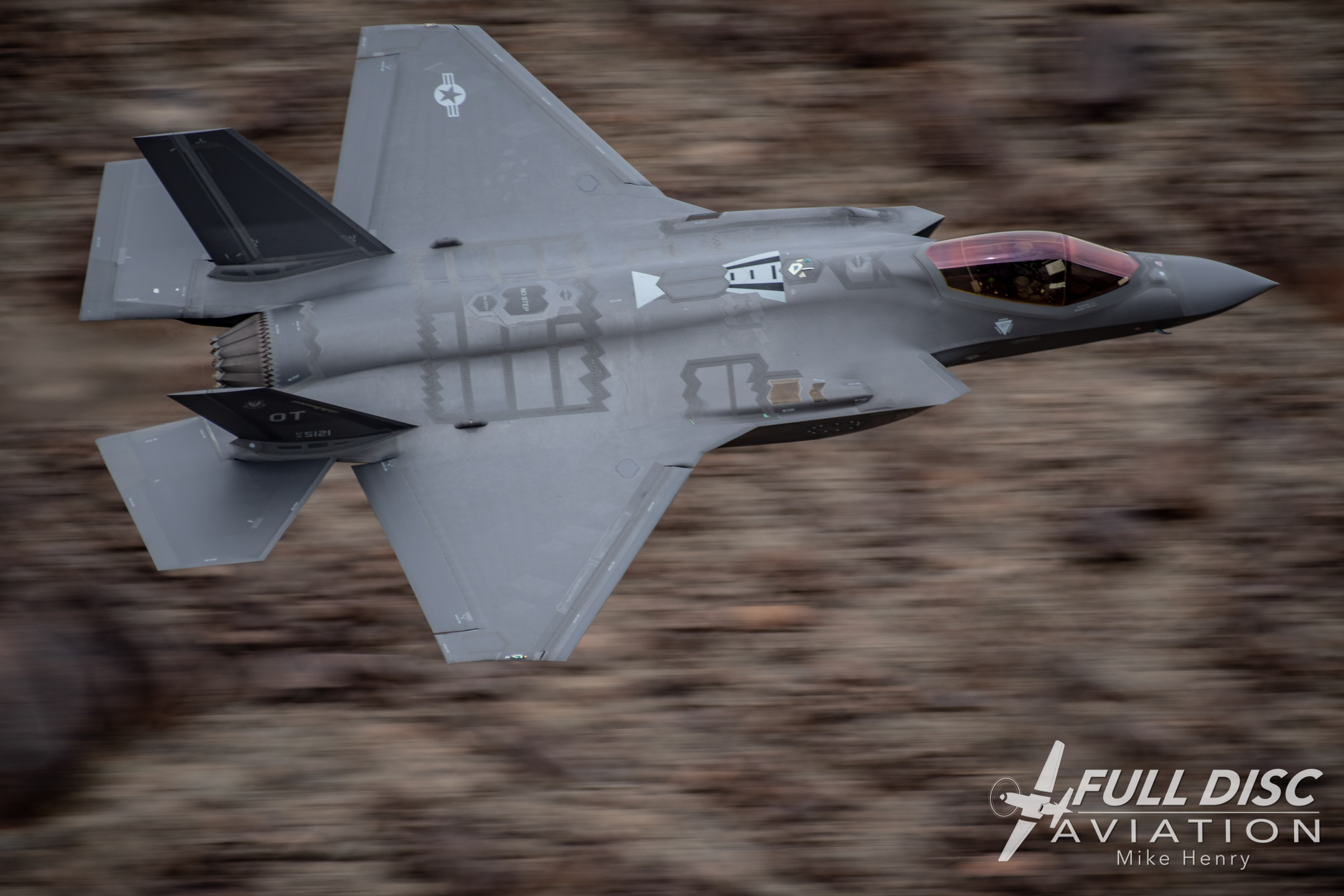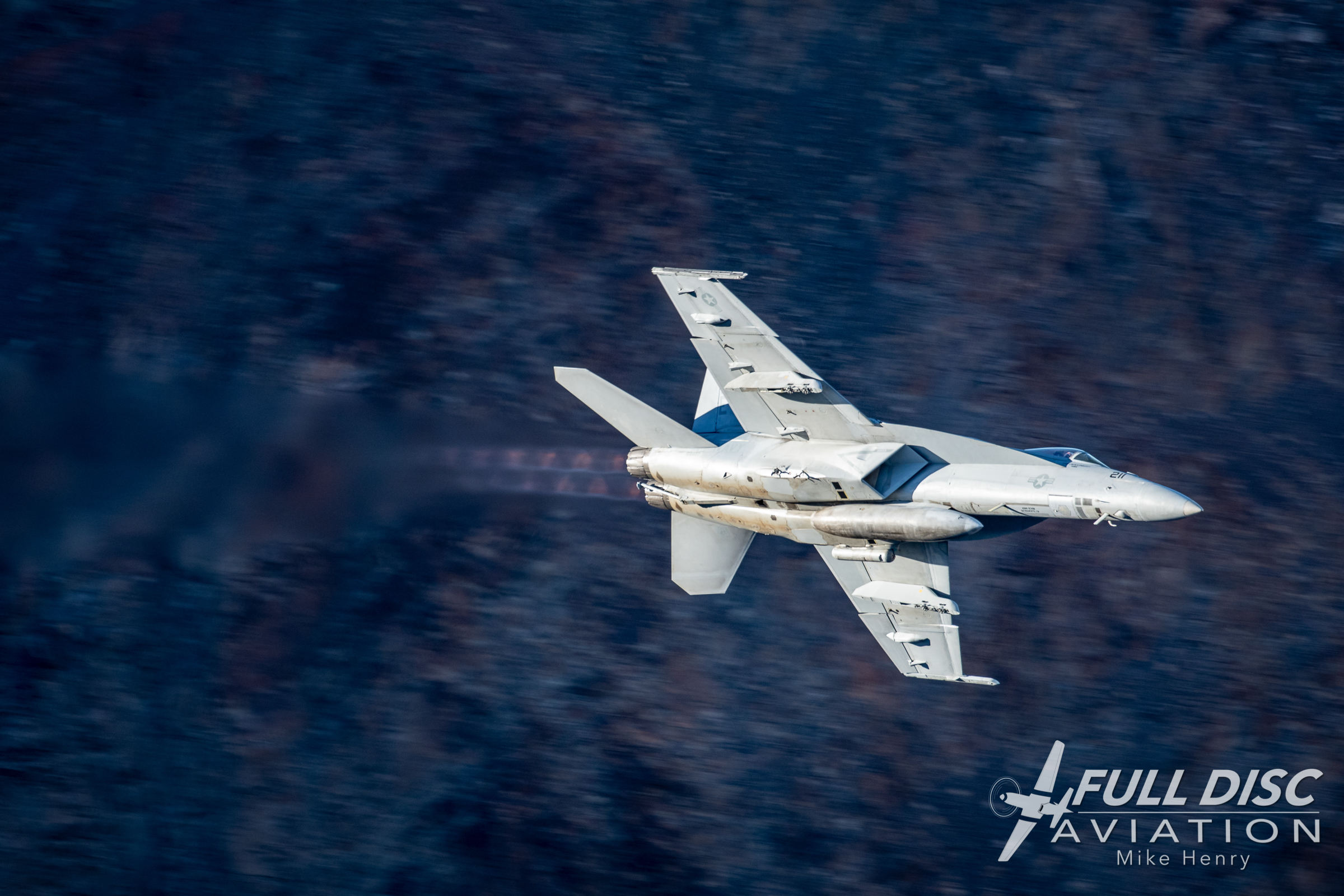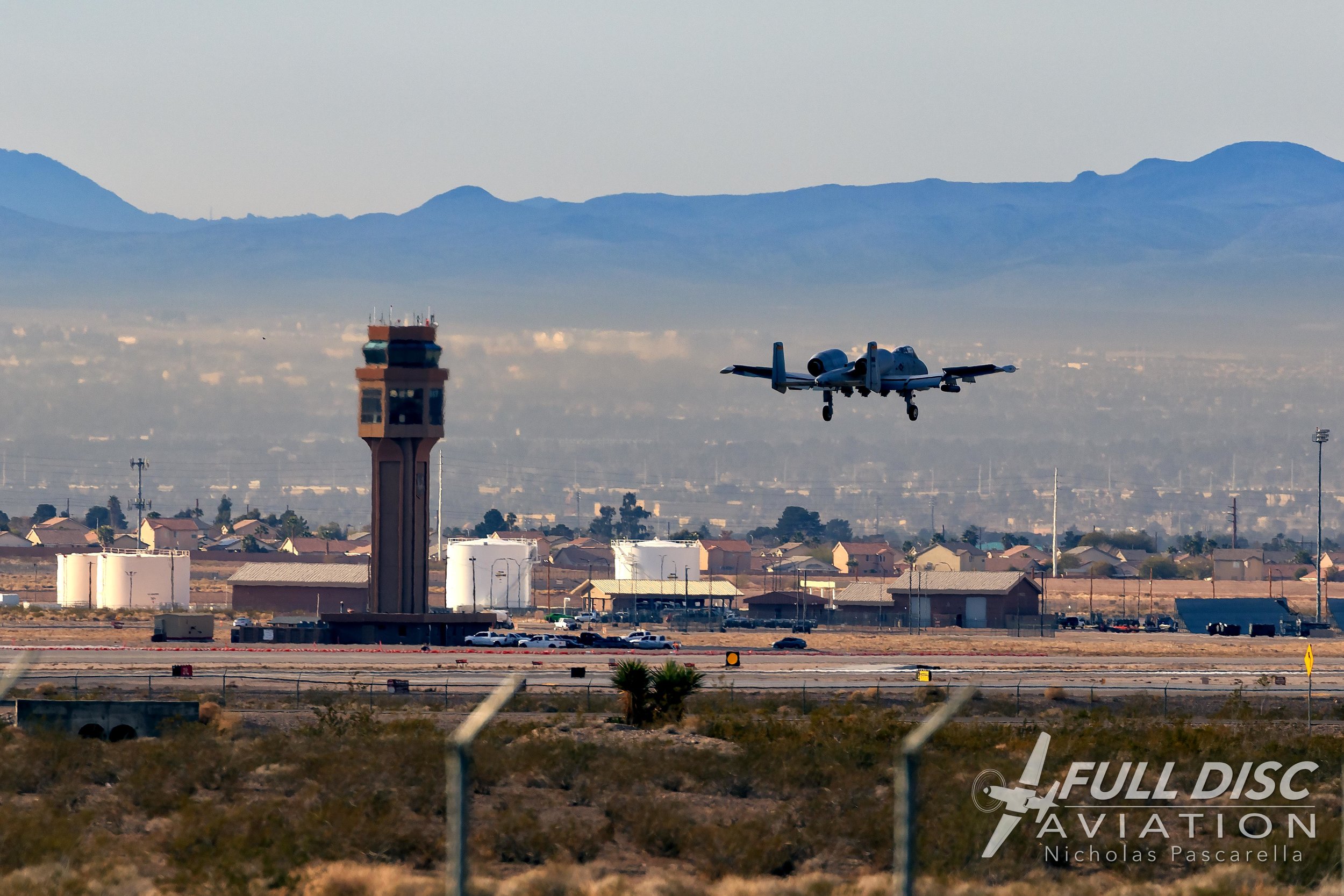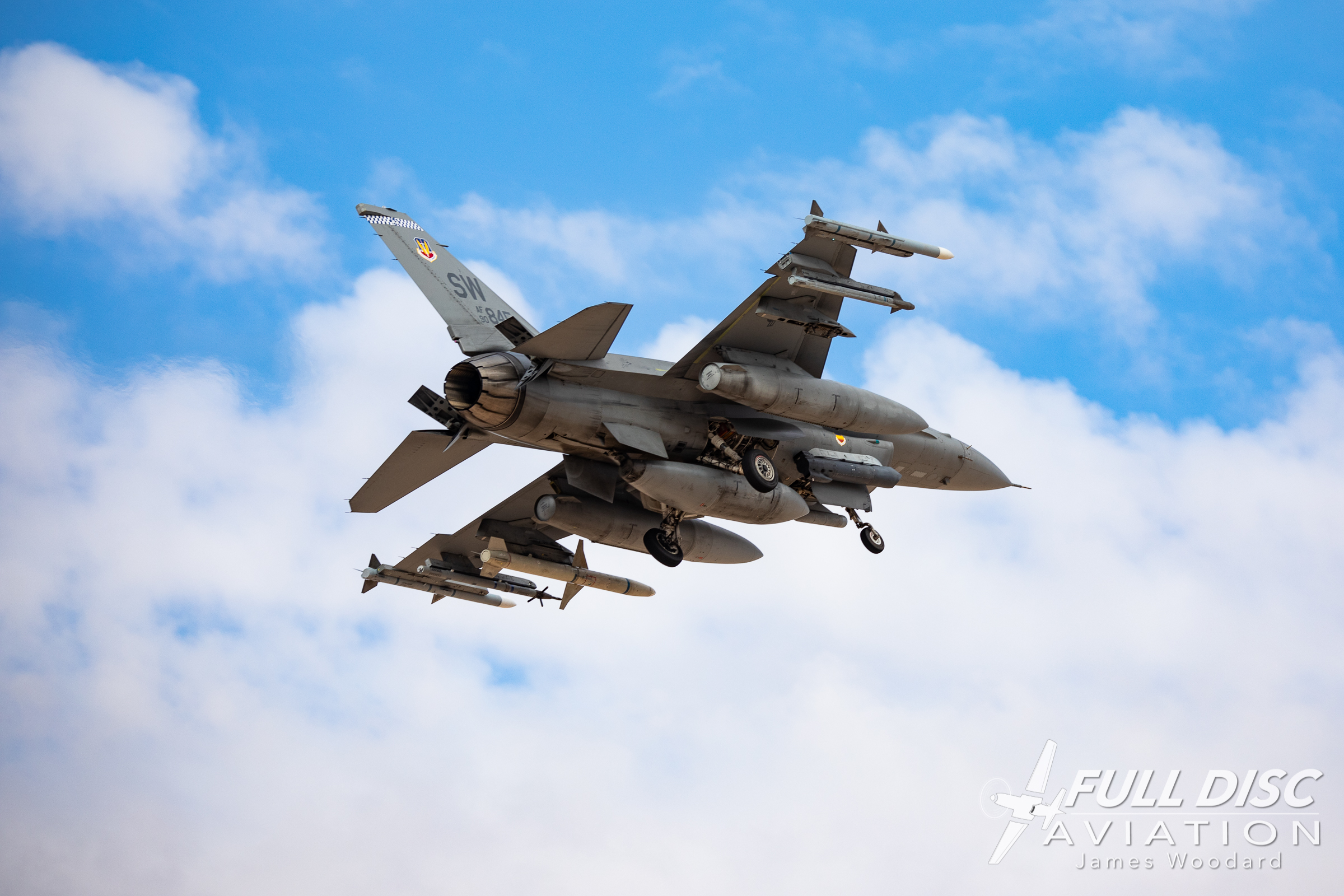Rainbow
Prose: Nicholas Pascarella
Photography: Nicholas Pascarella, James Woodard, Mike Henry
There is a special place in the American southwest desert for aviation geeks. It is not easy to get to. Even if you do manage to make the trip, you're quite unsupported by the comforts of civilization. One of the closest towns some 30 miles away is Keeler, with signs displaying the population: 20. Cell phone reception is non-existent for certain carriers. Any emergency would inevitably face a myriad of abnormal challenges. But...if curiosity overcame all those obstacles...if you planned and saved for months...if you lost sleep counting the hours...if you charged up and took the plunge...maybe the story would go something like this:
We left on a Sunday. We flew into Vegas, rented a car and drove off into a desert sunset. The orange ball sinking behind the shadowy mountains colored the sky fire, while my rearview mirrors reflected the purpley-blue scene behind us. We drove for hours alternating between curvy mountain passes and straight roads that trailed off into the supreme blackness of the desert night. The roadside reflectors miles down the road caught the high beams of our car and gave us the unsettling illusion we were often driving into a wall, and fast...but the wall never came. Just countless miles of straight, empty road.
We droned on through the night, exhausted from a whole day's worth of travel, closing to within an hour of our lodging in Lone Pine, California, when I saw the sign: Father Crowley Overlook. We had agreed not to stop; I pulled into the parking lot anyway. When I stepped out of our tired rental car and looked up, I nearly fell over. The dusty core of our Milky Way galaxy was clearly visible from horizon to horizon. I took a deep breath; these skies are some of the darkest in the contiguous US. We had agreed not to take pictures and just get a good night's sleep; we both pulled out the gear anyway.
We saw shooting stars. I laid on the pavement like I used to when I was a child to stargaze, the blacktop still warm from the day's sun. There were no noises. The air was dry and still. We were truly aware and wholly a part of the universe at this moment, and I've never felt so human and yet so alien at the same time. James was on the other side of the car shooting, and the only break in the silence was our camera shutters.
"This is peace, man," he said. He was right of course, speaking quietly as if we were in a solar library. I couldn't have said it any better myself. When I stood, I could hear my heartbeat and the blood rushing from my head. There was a canyon here, but even with our strong flashlights, we couldn't see the other side or the bottom. We would return…
We finished the drive, established a home base in Lone Pine, and toured up a mountain road for some more astrophotography. The stars twinkled like glitter while the red strobes of distant commercial aircraft blinked along the horizon. Visibility was unlimited. The desert opened her arms to us and we embraced her. Reluctantly, we fell back to home base for a recharge.
Up before dawn, laden with gear and supplies, we were back on the road in our struggling rental car. As the sun rose from beyond the horizon in front of us, it first illuminated the stark white peaks of Mount Whitney in my rear view and we both craned around backwards to see. The bright mountain sliced a jagged contrast through the dark purple sky of sunrise. I couldn't believe we were driving away from one of the most beautiful things I'd ever seen, but we had a different objective.
After 45 minutes of driving, we pulled into a turnoff near Father Crowley Overlook as the sun crested the far mountains of Panamint Springs. Our ragged rental car fussed over small rocks and bumps in the dirt, but we had arrived. Rainbow Canyon, also known as Star Wars Canyon due to its resemblance to the other-worldly Tatooine.
This 1000 foot-deep canyon was carved out of millions of years of Darwin Hills volcanic debris and lava flows. Rainbow Canyon clearly got its name from its varied composition, flush with wild desert colors in cake-like layers that are sometimes abruptly broken askew due to tectonic activity. From the bottom of the canyon past the sandy Dogbone of Panamint Springs to the top of the mountains, every color of the desert palette was on display. Gold, rose, copper, rust, sand, coral, pink, maroon, gray, bone, granite, even purple and green were visible in the rock. As the earth spun, these colors in their formations were selectively revealed by the sun with a fresh scene every few minutes. Its beauty was unrivaled. Just being here in the presence of millions of years of change was worth the trip, but we were waiting for something else...
The fighter pilots call this place the Jedi Transition.
Used as a low level training ground for a plethora of Navy, Marines and Air Force bases in the surrounding area, the Jedi Transition has been utilized since World War II to sharpen the low-level skills of our fighting aviators. In other words, pilots fly front line aircraft through the canyon. I had to repeat that thought to myself peering over the canyon walls; it didn't look that far to the other side. I hiked around the western rim to look straight down the canyon through to the Panamint ranges some 15 miles away and the expansive floodplain they call the Dogbone connecting the two; this place felt like a different planet. James and I had no idea where to set up shop to catch the best angles of the action; we needed a Canyon Sherpa to guide us.
Mike Henry (@mykenry) was up to the task. We hiked to the crest on the southwestern rim (the photographers call it "Pano" for its panoramic view) overlooking the canyon and met Mike after being caught off guard by two F-16's cruising high through the canyon. This is where we planted ourselves for the rest of the day, leaning into a stiff breeze and enjoying the scenes surrounding us. There were a number of photographers from the UK that joined us on top of the hill as well, and we were thankful for the extra eyes. Everyone kept alert, listening to the scanner and quartering the sky like a bunch of prairie dogs any time we heard rumbling.
The distant ka-whoomp of sonic booms bounced off the mountains across the desert floor to us from the jets' high speed corridors. High above or off in the distance, pairs of contrails followed one another. Sometimes we saw a tanker dragging a thirsty little friend across the sky. Sometimes hours would go by and we wouldn't see or hear anything but the dry desert vegetation squeaking as it rubbed against itself in the wind. Layers of clouds slid past the distant ranges, changing illumination on different features the way undulating waves filter underwater scenes. Then, finally, someone saw what we've been waiting for and promptly alerted everyone else. "Jet!"
In the flurry of activity that followed, each photographer simultaneously scanned the sky for the rapidly approaching aircraft and brought his equipment to bear, rushed to an unobstructed spot to shoot the pass from, and at the same time tried not to fall into the canyon down its steep, jagged slopes. More often than not, this preparation time was less than two seconds before the jet had rocketed down the hill west of the canyon, dove in and rounded the corner past the parking lot of Father Crowley. In 10 seconds, the event was over, with only the echoes of jet engines rumbling back to us from across the desert floor.
Each photographer alternately probed the western sky for a wingman and peeped the back of their cameras to see what they captured. It was hard to tell in the moment what I was shooting as the jet ripped past at 400mph, it's a challenge usually just to keep the jet in the frame with our telephoto lenses. "We got hands!" someone shouted, undoubtedly seeing the back seater of the last Super Hornet throwing us the peace sign as they dove in.
"The ultimate rush, ay?" one of our British friends commented. Absolutely. Yet this is all meaningful training; the skills acquired during these blasts through Jedi prepare the pilots and back seaters for maneuvering low in a target-rich environment, avoiding anti-aircraft fire, keeping their situational awareness up and staying under enemy radar. I also privately pondered, with immense respect, the simple fact that these aviators were taking on incredible risk and putting their lives on the line in the name of potentially life-saving training. Nowhere was this more evident than from the walls of Rainbow Canyon, where they push 30,000lb aircraft near the speed of sound mere feet from the rocky walls. Every part must work as it was designed to, every mechanism and pilot action must be flawless. The margin for error is zero.
With that said, the art of flight was also on full display here. Each pilot had his or her own approach and style, speed and feel. It was an artist in each cockpit drawing a line through the canyon. Even the entry and exit points were completely up to the whims of the hand on the stick. Sometimes the pilot wouldn't drop in at all. Sometimes they would only drop into the canyon for a second before pulling up. Some pilot's lines were elegant and smooth, banking easily and gracefully on a gentle downward slope. Others sat high on a perch on the mountain west of the canyon before abruptly banking and diving in with the cans lit, maneuvering violently through the turns, rolling nearly inverted and pulling vapor around the corner as they dive even lower towards the exit. Each line was its own poetry, each pilot had a flavor all their own.
And some pilots like to put on a show. "Gladys" flight of two Dutch F-35s have been known to make multiple passes for the photographers along the ridge, dragging shock waves with them. They would dive in at nearly the speed of sound with the burner lit, blowing over chairs on top of Pano. Our first day, we lucked into a Growler (a specialized Super Hornet) pilot and back seater who had some extra time to kill. They hit the canyon hard the first pass, blasting low and fast through the turns. At the exit, instead of heading across the Panamint Dogbone, the Growler rolled up on the port wing and disappeared behind the other side of the canyon. When the gray sawtooth shape popped up rounding the snow capped mountains northwest of the canyon, we all got a little closer to the edge.
The pilot banked hard to plunge in deeply once more, rounding the corner sharply. But this time, he pulled up over the parking lot, rolling inverted to bring the nose back down. Another 30 seconds later, he was rounding the snow capped mountains again, and I was gripping the camera so tightly that my heartbeat shook my viewfinder. He went in shallow this time. Instead of rounding the corner left, he rolled right, squared us up on top of Pano and blasted past us, both the pilot and back seater looking directly at us.
By this time we were all buzzing. The jet roar simmered to a rumble as we lost track of the Growler again, but the pilot had been rolling left when he disappeared...and he popped up near the snow capped mountains one more time. We all inched even closer to the edge to get the best angle of his dive in, but he had different ideas. Instead of diving in, he held the turn from the mountains steady and lit the cans, bringing him down the line of photographers just above our heads in a screaming afterburner flyby. He pulled up and away, burners throwing orange flame. We could smell the jet fuel. My hands were shaking.
We got 19 passes Monday. We headed back to Lone Pine in our sad rental car and followed Mike (who was in his truck) down rocky, bouncy dirt roads into the Alabama Hills to find the famous arch rock. We bumped along and eventually got to a turnoff, while James and I both worried that when we stopped the car and opened the door, the bumpers would comically fall off. We toasted a successful first day with Mike and then followed him down a sandy path to our objective. Mike pulled out some steel wool, stuffed it in an egg beater and lit it, swinging it around inside the arch for our long exposures, showering the area with patterns of warm light.
The next morning at dawn, we met Mike to shoot the sunrise on Mount Whitney near Owens Lake. The sunrise wasn't as nearly as dramatic as the previous morning, but the diffuse light lit the scene nicely and I finally got my road-to-the-mountains shot I've been pining for. On our walk back to the truck, Mike stopped us and pointed at big paw prints in the sand. "That's not a house cat," he said.
Our second day at Rainbow, we set up much farther down the canyon near the exit called the Amphitheater, situated between the two raised hills they call the Saddle. From this vantage point, it was a little more challenging to spot the jets before they dropped in, meaning the photo opportunities came and went quickly, but the reward was front three-quarter and topside shots as the jets banked around the exit corner. I hiked all the way to the top of the final Saddle; a rock scramble with massive 10 foot tall boulders resting precariously on the edge of the canyon. From here, the Jedi Transition appeared to spill its crumbling guts out into the infinite scrubby bushes and endless sand of the Dogbone floodplain.
There was a photographer 30 feet down the rock scramble in the teetering boulders, and we shouted greetings to one another. As I began a delicate, careful climb down to his perch, inevitably, he hit me with the call of the canyon: "Comin' in," and raised his lens. "Fantastic," I thought, balanced atop the staggering boulders at the very edge of the canyon. Immediately, a speeding F-35A blasted around the corner. "Another one," he called, and a second F-35A roared around the Saddle, pulling vapor ribbons into the Dogbone.
I made it back to the Amphitheater for more action including Mike's first Harrier through Jedi, and a color bird sporting a test tank at that. I also was fortunate enough to have my first F-15 experience in the wild since I was a child. Two California Eagles blasted through the canyon and then staged a dogfight above Panamint Springs. The two jets climbed and dove, merging repeatedly as they circled one another. They worked alongside each other at stall speed, standing the jets on their thrust. The roar of their engines reflected off the Panamint mountains and washed us with melody; we all watched in silence. After about 15 minutes, they flew off across the mountains.
Sadly, the flow of jets ran dry at 1400, and for the rest of the day, we played with a Lensball crystal and chased around a California Mouse, an enterprising canyon resident who kept stealing away with any crumbs we spilled from our snacks. On our drive back, it took 6 minutes to get from our parking spot near the exit of the canyon to Father Crowley Overlook; the jets use all of 4 seconds. We got 20 passes Tuesday.
On our way back to Lone Pine, we pulled off onto a dusty desert road to shoot some Joshua Trees, as I'd never shot one before. Mike brought his steel wool, cleared the brush and added a magical element to the photos as we shot long exposures through blue hour. At one point, slewed green lights and an offset red strobe passed over us slowly in the fog. We were wholly stumped and declared it to be an alien design. After all, we weren't all that far away from Area 51...
James led us back to the truck from our Joshua Tree but maybe the alien ship had scrambled his brains. He kept pulling left in the dark, eventually leading us parallel and then away from the road we were trying to find. Flashlights were no help when every direction we illuminated looked the same. Luckily my senses hadn't completely shut down for the day and I peeled off. I used the tiny bit of light left in the sky to get my bearings on the silhouettes of the surrounding mountains and overlaid a mental picture of our arrival; this guided me back the way we came. The tree was about 50 yards off the road, yet I found the road about 300 yards deeper into the desert than we started. I called to the guys who made their way to me. "See how easy it is to get lost out here at night?" Mike asked. I checked my phone and still had no service; getting lost out here would be a tough situation.
Wednesday, we decided to sleep through sunrise for a little extra rest. As we sluggishly ate some food before linking with Mike, James looked out the window and let out a disgusted grunt. The white peaks of Mount Whitney were once again exploding in stunning light against a dark dawn sky. I rolled my eyes melodramatically. Wasting no time, we hustled out the door with our gear and putted up Lubken Canyon Road in our feeble rental to briefly capture the scene before heading to Mike.
At Rainbow once more, we set up on top of Pano for the day's action. More than once, curious travelers pulled into the turnoff and hiked to our encampment. One day it was a Canadian couple who had been buzzed on the roadway. Another day, a man driving cross country from San Francisco to Chicago to see his parents before going into the Peace Corps stopped and joined us, but these conversations all started the same:
"What, uh...what are you guys all waiting for?"
"Jets."
"Like...fighter jets?"
"Yeah, they fly through the canyon."
"No way!"
"Stick around, you might catch something."
"Do you know when they're coming?"
"Nope. It's like fishing."
Apparently these other photographers were a little superstitious. Any new guest to our spot seemed to bring good favor with the aviation gods and a Hornet seemed to always appear around the time someone new showed up. The reactions from the newcomers were (understandably) always the same:
"Wooooooo!" they would exclaim, laughing, "That was crazy!" and we'd all smile back in agreement. The Canadian man was giddy. "I see why you guys hang out up here! I get it now." It's hard not to. Our friend Seanpaul (@blueline_images) showed up and immediately two Super Hornets dropped into Star Wars. After that, we hung out for almost two hours with no action except distant sonic booms until he hit the end of his available window. We said goodbyes, he headed out, and a minute after he left our perch on the canyon rim, two more Super Hornets dropped in. Apparently, the newcomer luck works both directions.
We got a number of burner passes from California F-15s and Super Hornets, hitting the corner hard enough for vapor to form over the wings. A Harrier dropped into the canyon over our heads. We got some CAG jets in gorgeous lighting. Eventually, the setting sun pulled the shade line up the canyon wall opposite of us far enough to crest the rim. With the whole canyon submerged in shadow, we all reluctantly agreed it was time to pack it up, there would be no more action through the Jedi Transition today. We thought.
Supposedly, no canyon trip is complete without The Big Miss.
We were nearly to the cars at the turnout when we heard jet noise. One of the Brits made the call: "Jet!" My stomach sank to my feet. I had my long lens stowed in my backpack with a folding chair on each shoulder, carrying a bag of our snacking trash, as I watched two F-35's trail long ribbons of vapor along the west mountain, silhouetted flawlessly against pink and blue cotton candy sunset skies as they dove into the canyon. James, Mike, and our friends from the UK had their long lenses out and were ready for the most part, but we all were in poor position to capture what was certainly a spectacular sunset pass. Sailors would've lauded the obscenities flowing out of my mouth.
James, Mike and I had some great burgers in town back at Lone Pine with a gentleman from Holland who was on his own, also there to shoot aircraft in the Jedi Transition. Word has it that Gladys, the Dutch flight of two F-35s, showed up the next day and gave a show to their fellow countryman, much to his appreciation. We said our goodbyes, slept for a few hours, and got up at 0300 to load up our beaten, wheezing rental car for the drive back to Vegas.
We passed the signs to Father Crowley in the blackness of predawn. A few hours into the drive, the horizon started glowing blue, eventually flowing through the spectrum of sunrise colors as we drove. The distance was deceptive, every highway was a rush to the mountains that stayed forever distant, no matter how fast we drove. Passing Creech AFB in Indian Springs, we saw a few military drones flying around; being so close to Area 51 put my nerves on edge.
After some fitful spotting around Nellis AFB, we caught a mass launch of colorful aggressor Vipers heading out. Hoping to catch the elusive Typhoons, we pushed the rental car drop-off window to the very last second until I finally caught a dark, delta-looking shape lifting off far down the runway through the heat haze. I hurriedly threw the glass up and focused on what I hoped would be my first Typhoon. It was not to be; I've never been so disappointed to see a Raptor.
We dropped off the rental (it held together, bless the poor thing), said our goodbyes and flew east. This whirlwind trip left no time for reflection; I could still smell the jet fuel. I could still hear the squeaking vegetation and the munching mouse against the expansive silence of the desert. I could still see a Super Hornet, illuminated by orange sunset light, dive past snow capped mountains into the shadows of the Jedi Transition below us. I could still feel my chest rattle as he hit the burners. I could still see the vortices as he streaked down the canyon, chasing his shadow around the exit corner and over the Dogbone of Panamint Springs.
I get it now.
**Special thanks to Kristen Broderick, Cathy Lovell, and especially our Canyon Sherpa Mike Henry for their expertise in preparation and execution of this journey
